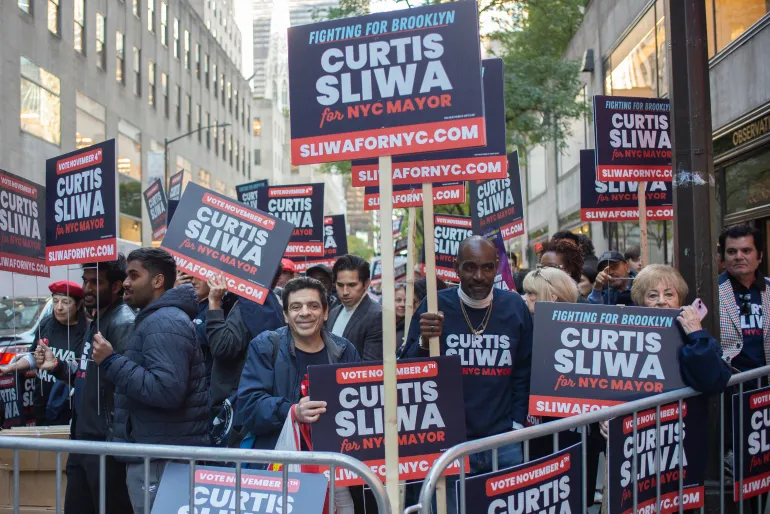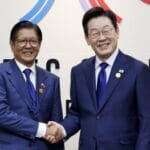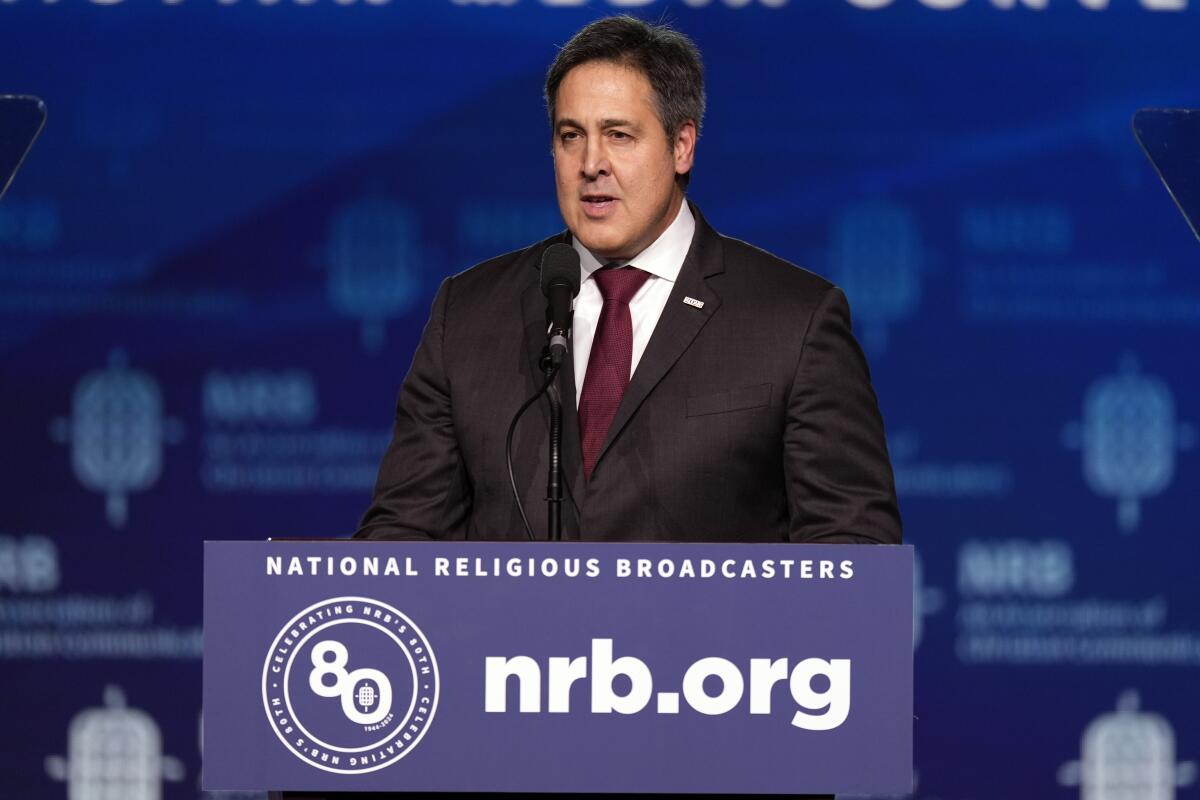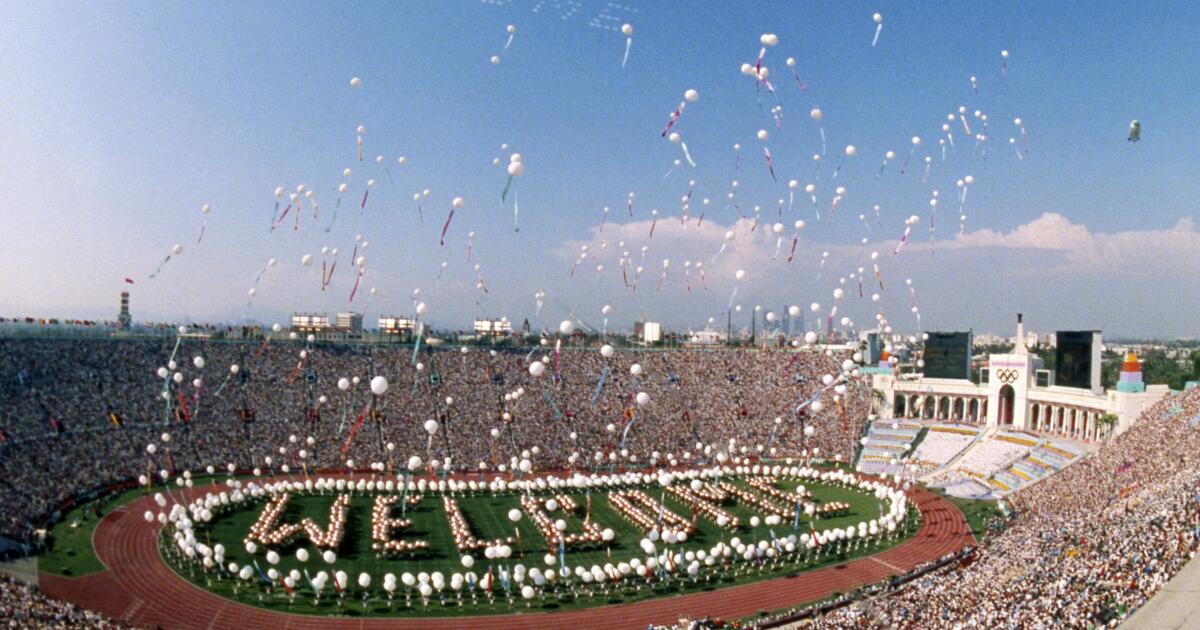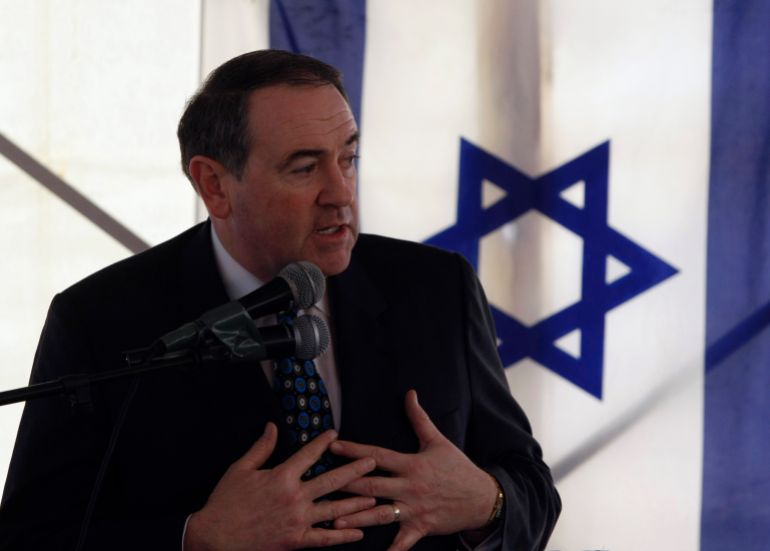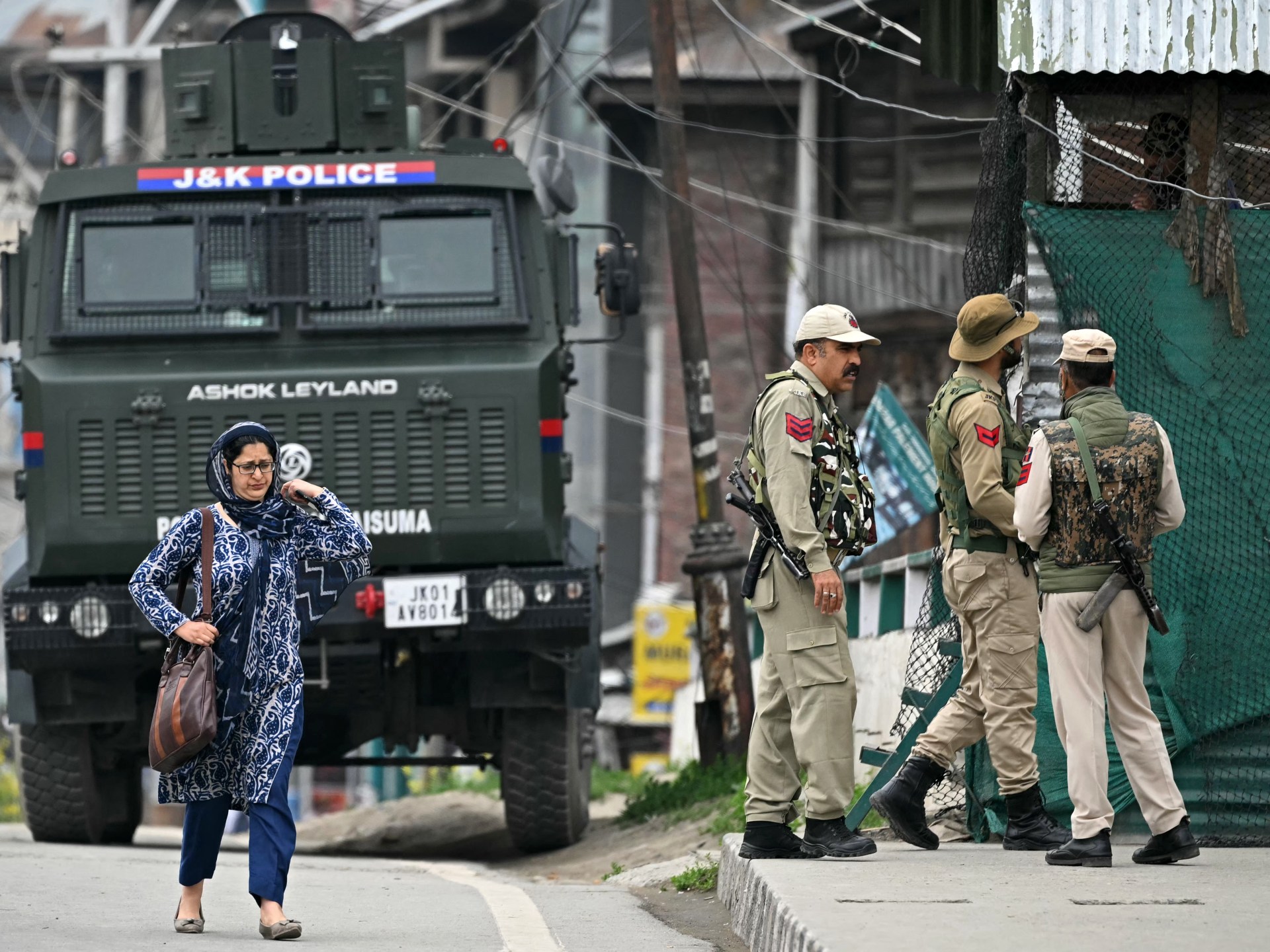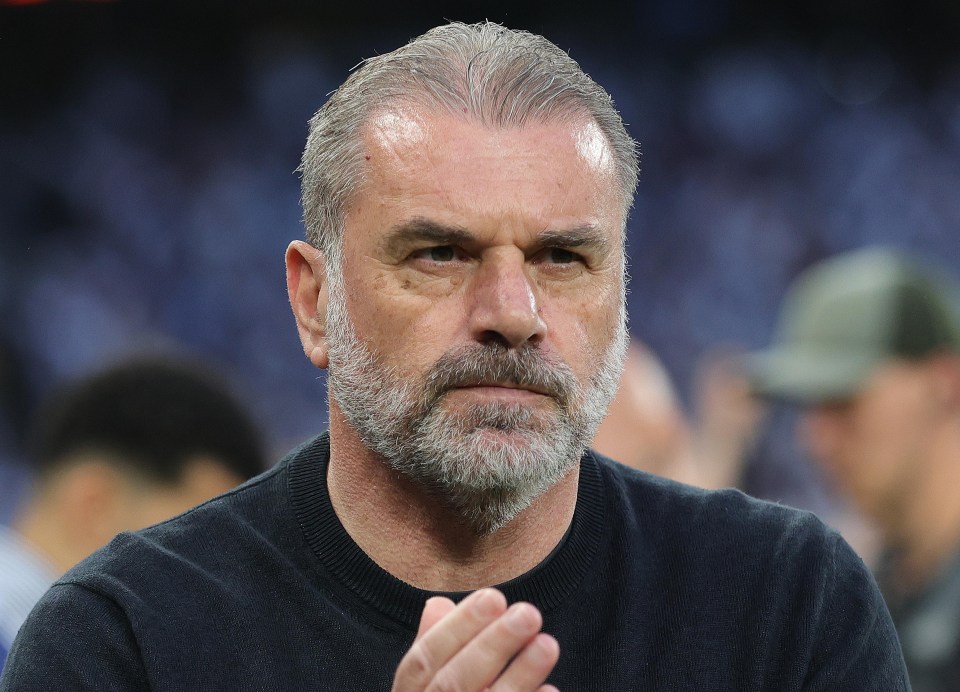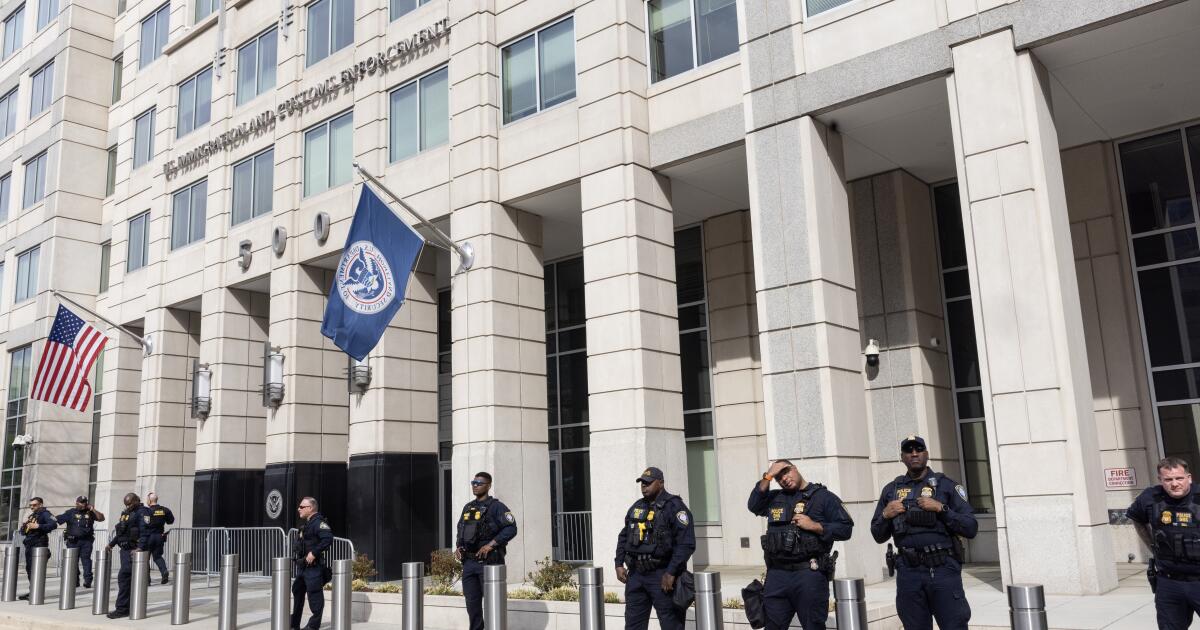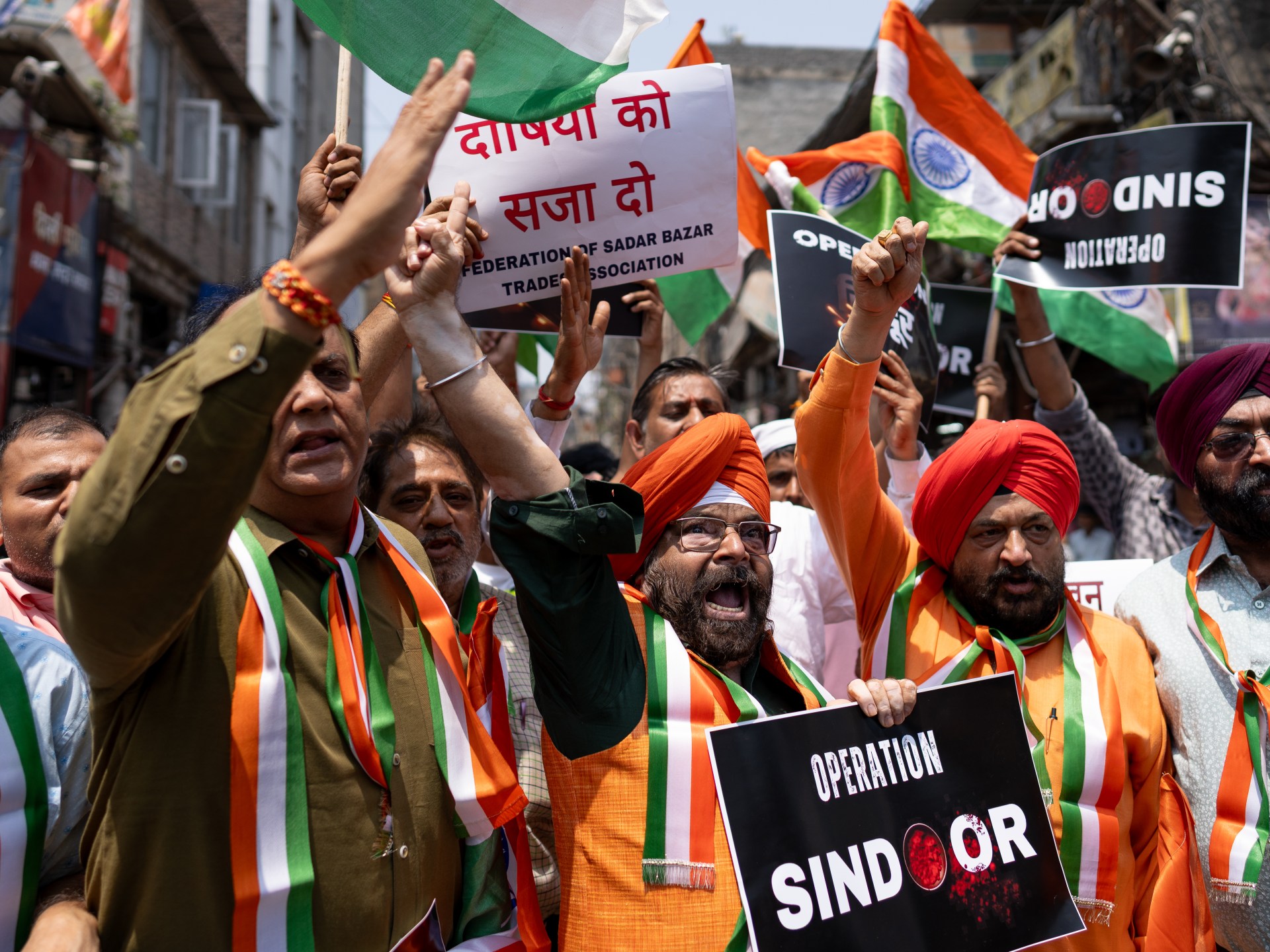
Trump’s policies so far closely align with Project 2025
In his Project 2025 chapter on trade, economist Peter Navarro called on the next U.S. president to bring about a domestic manufacturing “renaissance” by adopting reciprocal tariffs against trading partners and taking a particularly hard line on China.
Promptly after being elected, President Trump appointed Navarro as his senior counselor for trade and manufacturing. Within months, he announced sweeping new tariffs largely in line with Navarro’s suggestions.
When the stock market plunged and economists warned of increasing inflation and a potential recession, several of Trump’s other advisors rushed to step in, drive space between him and Navarro and prod the president into hitting pause on much of the plan.
The episode, which sent shock waves through the global economy, illustrated a broader pattern in which the president has rushed to implement unconventional or extreme policies also outlined in Project 2025.
He has done so despite having insisted throughout his 2024 presidential campaign that he wanted nothing to do with the unpopular, ultraconservative playbook, and despite warnings from experts and other liberal critics that such policies were unwise, if not illegal.
During the campaign, Trump said he hadn’t read Project 2025, which was released by the conservative Heritage Foundation in 2023, and didn’t intend to. He also said that some of its recommendations were “absolutely ridiculous and abysmal,” and two of his top campaign advisors — including his current chief of staff, Susie Wiles — said that “Project 2025’s demise would be greatly welcomed.”
Yet just as Project 2025 envisioned, Trump as president has pursued aggressive immigration enforcement, ordered a dramatic downsizing of the federal workforce in favor of loyalists, started dismantling the Department of Education, ordered new restrictions on voting, attempted to seize the power of the federal purse from Congress, set out to defund public media institutions and targeted transgender people with an array of threats, regulations and restrictions.
One prominent community tracking project says Trump has already implemented more than 40% of Project 2025’s recommendations. To help usher in those changes, he has appointed a cadre of Project 2025 contributors to powerful positions in his administration.
Asked about the broad alignment, White House Press Secretary Karoline Leavitt — who once appeared in a Project 2025 training video — suggested it wasn’t worth talking about.
“This is a stupid story to write and nobody cares,” Leavitt said in a statement to The Times. “President Trump makes policy decisions based on the best interests of the American people, period.”
Policy experts and liberal critics of the president disagreed.
They said Trump’s implementation of so many Project 2025 policies has hurt the economy and pushed the world’s most powerful democracy ever closer to an authoritarian, Christian nationalist regime, which is what Project 2025 called for, what made it unpopular and what its critics — and some of its supporters — warned would happen if Trump won.
Maya Wiley, president and chief executive of the Leadership Conference on Civil and Human Rights, a coalition of hundreds of civil rights organizations, said that Leavitt would suggest that “nobody cares” about Trump’s alignment with Project 2025 precisely because she knows they do care — and that an honest discussion about the overlap could alarm them and harm him politically.
It “matters that there is a plan, that it is an intentional plan, and that it is what Trumpism represents,” Wiley said.
Close policy alignment
In a recent report on Trump’s first 100 days in office, Michael Sozan and Ben Olinsky of the liberal Center for American Progress wrote that Trump has “waged a forceful and well-oiled effort with lightning speed to achieve — and even surpass — the ‘Second American Revolution’ envisioned by the authors of Project 2025.”
Paul Dans led Project 2025 at the Heritage Foundation until he left in July.
(George Walker IV / Associated Press)
Their assessment wasn’t far removed from that of Paul Dans, who led Project 2025 at the Heritage Foundation until his departure in July, when the plan was polling poorly and Trump wanted to distance himself from it.
In an interview with The Times, Dans said that he was “thrilled with the direction President Trump’s gone in the first 100 days,” and that he could not “find fault in anything that’s happened” under the new administration.
Dans said that the question of overlap between Trump’s agenda and Project 2025 was “irrelevant,” and that Trump was “delivering on the promises that he made to the American people.” But he also acknowledged substantial overlap existed, saying the “central tenet” of Project 2025 was “to deconstruct the administrative state,” and “the fact that [Trump] set out in earnest to do precisely that is very reassuring.”
“He’s coming out with a fierce urgency I don’t think we’ve seen in decades of governing,” Dans said.
Jon D. Michaels, a constitutional law professor at UCLA and co-author of a new book on right-wing authoritarianism under Trump, said the influence of Project 2025 and the conservative coordination that went into producing it is clear, especially in “the speed and effectiveness with which the second Trump administration is acting compared to the first.”
“It was very clear there was going to be an infrastructure in place to move from Day One, and that’s playing out,” Michaels said. “Everything is sort of hard-charging.”
One of the most prominent themes of Project 2025 is that the power of the federal government has for too long been held by a “sprawling federal bureaucracy” of liberal underlings and should be seized by the next conservative president. That was most forcefully articulated by the playbook’s principal author, Russell Vought, who served as director of the Office of Management and Budget during Trump’s first term.
Vought envisioned Trump moving quickly to “break the bureaucracy to the presidential will” by firing huge numbers of career federal employees, installing loyalists in positions of power and taking control of the federal purse strings from Congress.
When Trump was elected, he appointed Vought to again head OMB, and Vought, along with the Elon Musk-led Department of Government Efficiency, swiftly got to work. Within days of Trump’s inauguration, the OMB froze trillions of dollars in federal funding allocated by Congress. A month later, Vought prompted mass government layoffs by ordering federal agencies to “focus on the maximum elimination of functions that are not statutorily mandated.”
Immigration is another area where the Trump administration is heavily aligned with Project 2025.
The playbook said prioritizing “border security and immigration enforcement, including detention and deportation,” was crucial; called for many more detention beds to be created; and said U.S. Immigration and Customs Enforcement should rescind policies that precluded agents from conducting immigration enforcement in “sensitive places” such as schools, hospitals and churches.
The Trump administration has ordered the biggest mass deportation program in U.S. history, called for billions to be invested in massive new immigration detention facilities, and promptly did away with ICE policies barring raids at sensitive places.
In another area of alignment, Project 2025 called for an across-the-board attack on transgender people’s rights, proposing that all federal regulations that prohibit discrimination based on sexual orientation or gender identity be rescinded, that transgender service members be ousted from the military and that gender-affirming care be strictly limited.
It called for new bans on federal funding being used for gender-affirming care and for “gender ideology” to be removed from all school curricula, suggested transgender athletes were endangering girls’ sports, and called for the total erasure of transgender people in federal regulations, policies and materials.
Trump set about implementing those policies as soon as he took office.
His administration announced a ban on transgender service members, erased LGBTQ+-related materials across government, threatened local schools that allow transgender athletes to compete, threatened hospitals that provide gender-affirming care, and announced it was clawing back funding from organizations that provide healthcare to the LGBTQ+ community.
Russell Vought heads President Trump’s Office of Management and Budget after serving as the principal author of Project 2025.
(Mark Schiefelbein / Associated Press)
Similarities can also be found in an array of other areas.
Project 2025 called for dismantling the Department of Education; scaling back the U.S. Agency for International Development, which provides aid to impoverished nations around the world; shifting Justice Department resources toward prosecuting voter fraud, despite experts saying it is rare; dismantling “diversity, equity and inclusion” initiatives across government; and stripping federal funding from public media such as the Public Broadcasting Service and National Public Radio.
The Trump administration has set all of those policies in motion.
Momentum and resistance
With Trump in office, Project 2025 is well on its way to being implemented. That has prompted pushback and, in some cases, defeat.
Litigation by California and other states, private individuals and liberal advocacy groups has stopped some of Trump’s Project 2025-aligned policies while the courts consider their legality, and could permanently block them. In multiple cases, judges have found such policies or Trump’s unilateral implementation of them to be unconstitutional or illegal.
Congress, under the control of Republicans loyal to Trump, has shown little appetite to counter the president’s agenda, despite having substantial power to do so. However, their lockstep allegiance has shown some signs of fraying.
Edward Alden, a senior fellow at the Council on Foreign Relations who studies trade, said Trump has long been bullish on tariffs and in Navarro found the “one advisor who consistently supports what Trump believes on this stuff.” However, their ideas have been a “disaster” economically, Alden said, and could push more Republicans to challenge the president if the resulting market volatility persists.
“They’re not worried about his authoritarian tendencies. They’re cool with that stuff. But trade, not so much,” he said.
Dans said that most conservatives “are delighted to see the path” Trump is on, and that “RINOs” in Congress — an insult meaning “Republicans in Name Only” — had best get out of his way or risk being voted out by the MAGA base.
The president’s actions so far have been “a knockdown blow to the deep state, but not a knockout blow,” Dans said. “They’re going to get their breath back, and the question is going to be, can these reforms actually take root?”
Meanwhile, liberal activists say they are increasingly working together to resist Trump’s policies. Street protests have been ratcheting up, and civil rights groups are forming new alliances with other institutions under attack from the administration, including universities and law firms.
Wiley, of the Leadership Conference, said maintaining a unified and “very public” front will be essential in holding the line against Trump and Project 2025 into the future — both because “courage is contagious,” and because Project 2025 as a political framework will outlive Trump.
“Is it the president’s plan now? Yes. Was it the president’s plan [during the campaign], even though the president tried to distance himself? Yes. Will this end with Donald Trump’s presidency? No,” Wiley said.
Jenny Pizer, chief legal officer at LGBTQ+ legal advocacy group Lambda Legal, which is suing the administration over its transgender policies, agreed.
Pizer said those policies are the product of years of work by anti-LGBTQ+ and religious groups to convince everyday Americans that queer people represent a threat to their conservative values.
“This is the worldview that they want to impose on all of us, and it’s not new,” she said. “Project 2025 brings together multiple different reactionary themes into one enormous document that, to many of us, is a terrifying picture of a world that we do not want to live in.”
The Sports Report: Coliseum is set to make Olympics history
Newsletter
Go beyond the scoreboard
Get the latest on L.A.’s teams in the daily Sports Report newsletter.
You may occasionally receive promotional content from the Los Angeles Times.
From Thuc Nhi Nguyen: During the near decade since L.A. was awarded the 2028 Olympics, new venues have arrived, proposed venues have fallen through and sports have shuffled, but the centerpiece of the ever-evolving plan has always been clear.
The iconic stadium will host the opening and closing ceremonies for the 2028 Olympic and Paralympic Games, LA28 announced Thursday, officially locking in the organizing committee’s proposal. While the Coliseum will become the first venue to host the Olympics three times, the 2028 Games will also showcase one of the region’s newest cornerstones by using SoFi Stadium as a second venue for the Olympic opening ceremony and to host the opening ceremony for the Paralympic Games.
The dual-venue opening ceremony is a first for the Olympic Games, following another unprecedented format in Paris where athletes paraded down the Seine in boats.
“We’re going to be celebrating the past and we’re also going to be celebrating the future,” LA28 CEO Reynold Hoover said Thursday at a news conference held at the Coliseum. “It is what’s next. The iconicness of the Coliseum and all the things that it represents and the ’32 Games and the ’84 Games, and then the technology and the next stage of Games and experience that the Inglewood stadium represents is going to be an amazing juxtaposition.”
NBA PLAYOFFS RESULTS
All Times Pacific
Conference semifinals
Western Conference
No. 1 Oklahoma City vs. No. 4 Denver Nuggets
Denver 121, at Oklahoma City 119 (box score)
at Oklahoma City 149, Denver 106 (box score)
Friday at Denver, 7 p.m., ESPN
Sunday at Denver, 12:30 p.m., ABC
Tuesday at Oklahoma City, TBD, TNT
Thursday, May 15 at Denver, TBD, ESPN*
Sunday, May 18 at Oklahoma City, TBD*
No. 6 Minnesota Timberwolves vs. No. 7 Golden State
Golden State 99, at Minnesota 88 (box score)
at Minnesota 117, Golden State 93 (box score)
Saturday at Golden State, 5:30 p.m., ABC
Monday at Golden State, 7 p.m., ESPN
Wednesday at Minnesota, TBD, TNT
Sunday, May 18 at Golden State, TBD*
Tuesday, May 20 at Minnesota, 5:30 p.m., ESPN*
Eastern Conference
No. 1 Cleveland vs. No. 4 Indiana
Indiana 121, at Cleveland 112 (box score)
Indiana 120, at Cleveland 119 (box score)
Friday at Indiana, 4:30 p.m., ESPN
Sunday at Indiana 5 p.m., TNT
Tuesday at Cleveland, TBD, TNT*
Thursday, May 15 at Indiana, TBD*
Sunday, May 18 at Cleveland, TBD*
No. 2 Boston vs. No. 3 New York
New York 108, at Boston 105 (OT) (box score)
New York 91, at Boston 90 (box score)
Saturday at New York, 12:0 p.m., ABC
Monday at New York, 4:30 p.m., ESPN
Wednesday at Boston, TBD, TNT*
Friday, May 16 at New York, TBD, ESPN*
Monday, May 19 at Boston, 5 p.m., TNT*
*if necessary
DODGERS
From Jack Harris: It’s much too early to call it 2021 yet.
But, just like the last time the Dodgers tried to defend a World Series title, the National League West isn’t presenting the easiest of paths.
Entering Thursday night, the division was home to the best team in baseball, the 25-win Dodgers. But, based on overall league records, it also included the clubs ranked third (San Diego at 23-13), fifth (San Francisco at 24-14) and 13th (Arizona at 19-18) in the majors, too.
“I think we’re the best division in baseball,” Dodgers manager Dave Roberts said. “I don’t think anyone is gonna run away with it.”
In 2021, of course, the Dodgers faced a similar test in the NL West. That year, the division wasn’t as deep, the bottom three teams all finishing below .500. But at the top, the Dodgers and Giants duked it out to the end. The Dodgers finished with 106 wins. The Giants topped them with 107. It forced the Dodgers to settle for a wild-card berth in the playoffs, and down an elongated October path that saw them run out of steam in the NL Championship Series.
While this season isn’t even at its quarter-point yet, a similar threat is starting to brew.
In a 5-3 loss to the Arizona Diamondbacks on Thursday night, the Dodgers got their first taste of the challenge that might lie ahead. Over the next several weeks, plenty more intradivision tests loom.
Shaikin: Agent Nez Balelo ‘wouldn’t do anything different’ with Shohei Ohtani’s $700-million deal
Hernández: Shohei Ohtani pitching this season initially felt like a luxury. Now it’s a necessity
ANGELS
Anthony Santander hit a go-ahead, two-run single during Toronto’s four-run sixth inning, and the Blue Jays snapped their four-game losing streak with an 8-5 victory over the Angels on Thursday night.
Daulton Varsho homered and drove in three runs on three hits for the Jays, who rallied from an early four-run deficit with 14 hits to avoid a series sweep. Vladimir Guerrero Jr. also had three hits as Toronto won for just the fifth time in 17 games.
Taylor Ward and Jo Adell hit early homers for the Angels, who failed to earn their first series sweep.
DUCKS
Joel Quenneville returned to hockey Thursday with contrition. He acknowledged mistakes and said he accepted full responsibility for his role in the Chicago Blackhawks sexual assault scandal.
The second-winningest coach in NHL history said he is a changed man after nearly four years away from the game. As he took over behind the bench of the Ducks, he vowed to continue to educate himself about abuse, to expand his work with victims, and to create a safe workplace with his new team.
Quenneville also realizes that’s not nearly enough to satisfy a significant segment of hockey fans who believe his acknowledged inaction during the Blackhawks scandal should have ended his career.
“I fully understand and accept those who question my return to the league,” Quenneville said. “I know words aren’t enough. I will demonstrate (by) my actions that I am a man of character.”
NHL PLAYOFFS SCHEDULE, RESULTS
All times Pacific
Conference semifinals
Pacific 1 Vegas vs. Pacific 3 Edmonton
Edmonton 4, at Vegas 2 (summary)
Edmonton 5, at Vegas 4 (OT) (summary)
Saturday at Edmonton, 6 p.m., TNT
Monday at Edmonton, 6:30 p.m., TNT
Wednesday at Vegas, TBD, ESPN*
Friday, May 16 at Edmonton, TBD, TNT*
Sunday, May 18 at Vegas, TBD, TNT*
C1 Winnipeg vs. C2 Dallas
Dallas 3, at Winnipeg 2 (summary)
Friday at Winnipeg, 6:30 p.m., TNT
Sunday at Dallas, 1:30 p.m., TBS
Tuesday at Dallas, 5 p.m., ESPN
Thursday at Winnipeg, TBD, TNT*
Saturday, May 17 at Dallas, TBD*
Monday, May 19 at Winnipeg, TBD, ESPN*
Eastern Conference
Atlantic 1 Toronto vs. Atlantic 3 Florida
at Toronto 5, Florida 4 (summary)
at Toronto 4, Florida 3 (summary)
Friday at Florida, 4 p.m., TNT
Sunday at Florida, 4:30 p.m., TBS
Wednesday at Toronto, TBD, ESPN*
Friday, May 16 at Florida, TBD, TNT*
Sunday, May 18 at Toronto, TBD, TNT*
Metro 1 Washington vs. Metro 2 Carolina
Carolina 2, at Washington 1 (OT) (summary)
at Washington 3, Carolina 1 (summary)
Saturday at Carolina, 3 p.m., TNT
Monday at Carolina, 4 p.m., TNT
Thursday at Washington, TBD, TNT
Saturday, May 17 at Carolina, TBD*
Monday, May 19 at Washington, TBD, ESPN*
* If necessary
THIS DAY IN SPORTS HISTORY
1930 — Gallant Fox, ridden by Earl Sande, wins the Preakness Stakes by three-quarters of a length over Crack Brigade. Gallant Fox becomes the only Triple Crown winner to win the Preakness a week before the Kentucky Derby.
1932 — Burgoo King, ridden by Eugene James, withstands a strong drive by Tick On to win the Preakness Stakes by a head.
1942 — Alsab, ridden by Basil James, wins the Preakness Stakes by one length over Requested.
1944 — Jockey Walter Warren is involved in a rare feat in thoroughbred racing history, riding two horses to dead heat first-place finishes at Sportsman’s Park. In the sixth race, Warren rides Maejames to a dead heat finish with Piplad. In the eighth, Warren rides Susan Constant in another dead heat with Three Sands.
1990 — Sampdoria of Italy win 30th European Cup Winner’s Cup against Anderlecht of Belgium 2-0 in Gothenburg.
1993 — The Phoenix Suns beat the Lakers 112-104 in overtime to become the first NBA team to lose two playoff games at home and come back to win three straight games.
2004 — Jay Bouwmeester scores the winning goal, and Canada rallies to beat Sweden for the second straight year in the gold-medal game at the world hockey championships, 5-3.
2006 — Joffrey Lupul becomes the first player in NHL playoff history to cap a four-goal game with an overtime score, netting the game-winner at 16:30 of the extra period to give the Ducks a 4-3 victory over Colorado.
2009 — LeBron James scores 47 points to lift Cleveland to a 97-82 win over Atlanta. The Cavaliers sets an NBA record with its seventh straight double-figure win to eclipse the mark set by the 2004 Indiana Pacers.
2011 — The ATP and WTA tennis rankings are released with no American man or woman in the top 10 for the first time in the 38-year history of the rankings. Mardy Fish and Andy Roddick are Nos. 11 and 12, while Serena and Venus Williams were Nos. 17 and 19, respectively.
2016 — Stephen Curry returns from a sprained right knee to score an NBA-record 17 points in overtime, finishing with 40 as the Golden State Warriors rally to take a 3-1 lead in the Western Conference semifinals with a 132-125 victory over the Portland Trail Blazers.
2018 — Manchester City smashes EPL records in 3-1 win over Brighton — most goals (105), most points (97) and most wins (31).
2018 — The Lehigh Valley Phantoms beat Charlotte Checkers 2-1 in the longest game in the 82-year history of the American Hockey League. Alex Krushelnyski’s goal at 6:48 of the fifth overtime period gives the Phantoms a 3-1 lead in the best-of-seven Atlantic Division Finals series.
2019 — English clubs create football history by taking all 4 final spots in Europe’s 2 major competitions; Chelsea & Arsenal qualify in Europa Cup after ‘miracle’ Champions League wins for Liverpool & Spurs.
THIS DAY IN BASEBALL HISTORY
1901 — Earl Moore of the Cleveland Indians pitched nine hitless innings against the Chicago White Sox before giving up two hits in the 10th to lose 4-2.
1937 — Ernie Lombardi of the Cincinnati Reds went 6-for-6 in a 21-10 rout of the Phillies in Philadelphia.
1947 — In his first game outside of New York City, Jackie Robinson has two hits and scores twice in the Dodgers’ 6-5 loss to the Phillies.
1961 — Jim Gentile of the Baltimore Orioles hit consecutive grand slams in the first and second innings of a 13-5 rout of Minnesota.
1962 — Brooks Robinson becomes the 6th major leaguer this century to hit grand slams in back-to-back games, as he hits one against Kansas City’s Ed Rakow. Baltimore wins, 6-3, at home.
1967 — Cardinals outfielder #9 Roger Maris hits his first National League home run on the ninth day of the month in seat 9 of section 9.
1973 — Johnny Bench of the Reds hit three home runs off Philadelphia’s Steve Carlton for the second time in his career. Bench drove in seven runs in Cincinnati’s 9-7 victory.
1984 — The Chicago White Sox and Milwaukee Brewers played for 8 hours, 6 minutes in the longest game. After playing 17 innings the previous day, the teams met again before a regularly scheduled game, making the total 34 innings for two days. Harold Baines homered off Chuck Porter with one out in the bottom of the 25th for a 7-6 victory. Tom Seaver won both games for the White Sox.
1987 — Baltimore’s Eddie Murray became the first major leaguer to homer from both sides of the plate in consecutive games as the Orioles beat the Chicago White Sox 15-6 at Comiskey Park.
1993 — Cubs 1B Mark Grace hits for the cycle in Chicago’s 5-4 loss to the Padres. He is the 14th Cub to do so.
1999 — Marshall McDougall hit six consecutive homers and knocked in 16 runs — both NCAA records — in Florida State’s 26-2 rout of Maryland. The second baseman opened with an RBI single, then hit six straight homers. After his base hit, McDougall had a solo homer in the second inning, a three-run shot in the fourth, a solo homer in the sixth, a three-run shot in the seventh, a grand slam in the eighth and a three-run shot in the ninth.
2006 — Tampa Bay prospect Delmon Young was suspended for 50 games without pay by the International League for throwing a bat that hit a replacement umpire in the chest. IL president Randy Mobley said he believed the suspension was the longest in the league’s 123-year history. The suspension is retroactive to April 27, the day after Young tossed his bat in a Triple-A game while playing for Durham.
2010 — Dallas Braden pitched the 19th perfect game in major league history, a dazzling performance for the Oakland Athletics in a 4-0 victory over the Tampa Bay Rays. He struck out six in the 109-pitch performance, throwing 77 strikes in his 53rd career start.
2011 — Zack Greinke wins his first game for the Milwaukee Brewers, striking out 9 batters in 6 innings in a 4-3 win over San Diego at Miller Park.
2013 — For only the third time ever, the reigning Cy Young Award winners face off. David Price and R.A. Dickey get no-decisions as the Rays top the Blue Jays, 5-4. The other match-ups had been Orel Hershiser vs. Frank Viola in 1989 and Tom Glavine vs. Roger Clemens in 1999.
2015 — Bryce Harper did it again, extending his remarkable homer streak with a two-run shot in the bottom of the ninth inning that sent the Washington Nationals over the Atlanta Braves 8-6. Harper homered for the sixth time in his last three games, one off the major league record set by Shawn Green in 2002.
2019 — With a solo homer in the 3rd inning in a 13-0 win against the Tigers, Albert Pujols of the Angels becomes the fifth player in major league history to collect 2,000 RBIs.
Compiled by the Associated Press
Until next time…
That concludes today’s newsletter. If you have any feedback, ideas for improvement or things you’d like to see, email me at [email protected]. To get this newsletter in your inbox, click here.
Ukraine accuses duo of spying for Hungary | Russia-Ukraine war News
Hungary, whose government maintains support of Russian narratives over war in Ukraine, is accused of seeking defence data.
Ukraine has detained two people who it accuses of spying for Hungarian military intelligence.
The SBU security service claimed in a statement on Friday that the former members of the Ukrainian military were recruited by Hungary to conduct “espionage activities to the detriment of our state”. Relations between Kyiv and Budapest have long been strained, but the antipathy has grown amid Russia’s invasion of Ukraine.
The Ukrainian intelligence agency said that the pair had been recruited by a handler in Hungarian military intelligence to gather information about defence systems in the country’s west, host to a significant Hungarian diaspora.
There was no immediate response from the Hungarian government.
The SBU said the two suspects, a 40-year-old man and a woman, had been placed in custody and given notice that they were under suspicion of committing treason. They both now face up to life in prison, it added.
The pair was allegedly given cash and special equipment for secret communication and tasked with passing on details about air defence batteries and other military capabilities in the western Zakarpattia region bordering Hungary.
The SBU alleged the man had tried to recruit at least two people as informants.
It added that this was the first time in the history of Ukraine that a Hungarian spy network had been found to be working against Kyiv’s interests.
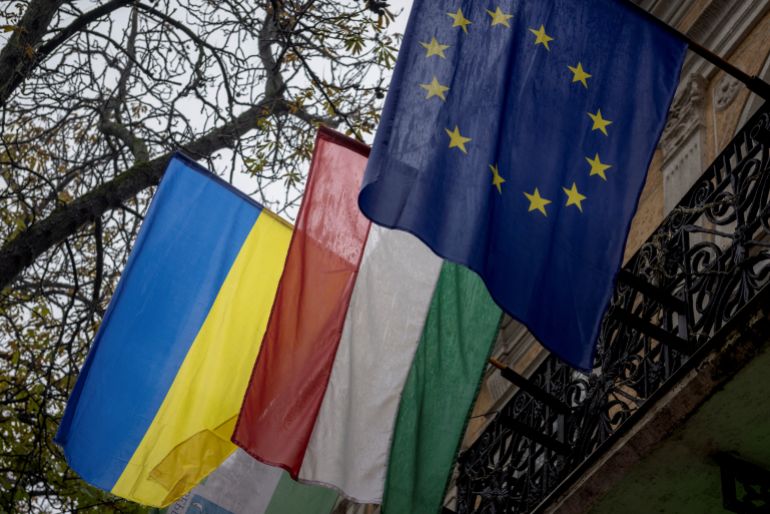
Throughout the Ukraine war, Hungarian Prime Minister Viktor Orban has delayed Western military aid to Kyiv and maintained warm relations with Russian President Vladimir Putin, at odds with his European Union peers.
Orban has used staunch nationalism to build his political base at home, in particular stressing grievances over the territories lost to neighbouring states – including Ukraine – under the Versailles Treaty that ended World War I.
Budapest has berated Kyiv for years, claiming discriminatory actions against the 150,000 or so ethnic Hungarians, most of whom live in the Zakarpattia region.
The SBU noted that the suspected agents had also been tasked with studying “the socio-political views of local residents, in particular, scenarios of their behaviour if Hungarian troops entered the region”.
US foundation eyes takeover of Gaza aid | Israel-Palestine conflict News
US-backed Gaza foundation proposal to keep aid from Hamas, but critics slam bypass of UN, Israeli threat to besieged Palestinian civilians.
The United States has said a new foundation is being established to coordinate aid deliveries to Gaza amid Israel’s two-month blockade.
US Ambassador to Israel Mike Huckabee told reporters on Friday that Israel would not be involved in distributing aid in the enclave but would provide security for the operations of the Gaza Humanitarian Foundation (GHF).
The plan for the “charitable” and “non-governmental” initiative was announced on Thursday by State Department spokeswoman Tammy Bruce. Although few details were revealed, it appears part of a US-Israeli push to take over the distribution of aid to prevent it from being diverted by Hamas and other groups.
The AP news agency reported that the newly created GHF had issued a proposal to implement a new aid distribution system, supplanting the current one run by the United Nations and other international aid agencies.
Reports claim that under the proposal, private contractors will be used to secure hubs where Palestinians will be required to gather to collect supplies.

Israel, which has halted the entry of all aid to Gaza since March 2, deepening the humanitarian crisis, has previously said it will not relax the blockade until a system is in place that gives it control over the distribution, insisting that supplies are used to support Hamas.
The intention to sideline the United Nations has drawn sharp criticism from humanitarian organisations, and it is unclear if the GHF proposal will ease those concerns.
Bruce promised further announcements regarding the proposal would follow soon. “I was hoping to introduce it today, but the foundation will be announcing this shortly,” she said.
The former executive director of the UN World Food Programme David Beasley is in talks with the US, Israel and other key players to head the GHF, reported US outlet Axis, quoting unnamed sources.
Israel’s blockade, implemented about two weeks before it resumed its bombardment of the enclave, has left Gaza’s 2.3 million Palestinians, most of whom have been displaced multiple times, desperately short of food, fuel, and medicine.
Israeli ‘aid plan’
The US plan appears to be designed along similar lines to a proposal approved by Israel’s security cabinet on Sunday.
Under the scheme, four “Secure Distribution Sites” would be constructed, each intended to serve 300,000 people. Palestinians expelled from northern Gaza would be forced to relocate to reach the centres.
The plan was met by sharp criticism from the UN and other aid groups, who noted that Palestinians have regularly come under attack from Israeli forces while collecting aid.
Addressing those concerns, Huckabee on Friday said “the most significant danger is not doing anything” and “people dying from hunger”.
The aid would be “distributed effectively, but also safely”, the US official insisted, according to Israeli daily Haaretz.
The decision to bypass international aid agencies comes amid growing alarm over famine-like conditions in the besieged territory, where Israel’s near-total blockade has cut off all essential supplies for almost three months.
At least 57 Palestinians have starved to death in Gaza, with most of the victims being children, as well as the sick and elderly.
UN humanitarian agency spokesperson Jens Laerke condemned the effort to dismantle existing aid structures on Tuesday.
“This appears to be a deliberate attempt to weaponise the aid,” he said. “It should be based solely on humanitarian need.”
Grammy-winning rock singer CANCELS tour in emotional statement after pulling out of a string of gigs – leaving fans devastated
AN AWARD-winning star has been forced to cancel her tour due to concerning health issues.
News from the US indie rock singer’s official social media account has shocked and saddened fans.
Julien Baker has cancelled her tour with Torres in order to ‘focus on her health‘ and any remaining dates have been scrapped.
The official statement read: “Due to recent events, Julien Baker is prioritising her well-being and taking time to focus on her health.
“Therefore, the Julien Baker & TORRES ‘Send A Prayer My Way’ Tour has been cancelled.
“This decision was not made lightly, and we understand the disappointment this may cause for fans. We deeply appreciate your understanding.”
It continued: “Refunds and ticketing information will be provided by the original point of purchase.
“Thank you for your continued support and compassion.”
The Not Strong Enough star was next set to take to the stage in Greenfield, Massachusetts on 20 June.
The 29-year-old’s last sold-out show was on Thursday, May 1 in New Orleans.
Just days ago on Instagram, Baker shared a video with the caption: “Getting to play these songs for y’all has been unbelievably fun… Keep an eye out for more tour news soon.”
Cancellation of the Boygenius’ star – who performs alongside Phoebe Bridgers and Lucy Dacus – has sparked concerns from fans.
One wrote on Reddit: “Damn hope she’s okay.”
A second penned: “Damn this reads as very serious. I hope she’s ok and takes care of herself – you can always tour again but you can’t undo harm to your health.”
A third queried: “Recent events?? I missed a chapter.”
A fourth questioned: “Sounds like mental health stuff?”
Another alarmed fan wrote: “Ugh – heartbreaking for her and the fans. Hoping she is ok! I JUST saw them in New Orleans last week.”
India-Pakistan tensions: A brief history of conflict | India-Pakistan Tensions News
India and Pakistan are locked in a rapidly escalating military exchange that threatens to explode into a fully fledged war, triggered by a deadly attack on tourists in Indian-administered Kashmir on April 22 in which 26 civilians were killed, but rooted in decades-old hostilities.
On May 7, India launched a wave of missiles into Pakistan and Pakistan-administered Kashmir, striking at least six cities and killing at least 31 people – including two children – according to Islamabad. Since then, Indian drones have hit major Pakistani cities and military installations, and India has accused Pakistan to launching a barrage of missiles and drones at its cities and military facilities.
Alongside the missiles and drones, the nuclear-armed neighbours have also traded allegations and denials. India says its May 7 missiles only struck “terrorist infrastructure” while Pakistan insists civilians were killed. Pakistan denies that it launched missiles or drones towards India, and both claim to be victims of the other’s aggression.
Yet the origins of this latest crisis between India and Pakistan go back to their very formation as sovereign nation states in their current form. Here is a recap of the state of near-constant tensions between the South Asian neighbours.
1940s-50s: A tale of two countries
The Indian subcontinent was a British colony from 1858 until 1947, when British colonial rule finally ended, splitting the subcontinent into the two countries. The Muslim-majority Pakistan gained its independence on August 14 that year as non-contiguous and culturally distant zones, West Pakistan and East Pakistan. The Hindu-majority but secular India gained its independence on August 15, 1947.
The partition was far from smooth, causing one of the largest and bloodiest human migrations ever seen, displacing about 15 million people. The process also sparked horrific communal violence and riots between Muslims, Hindus and Sikhs across the region, in which between 200,000 and two million people died. Border disputes and separatist movements sprang up in the aftermath.
What stuck out as a major sticking point between the neighbours was the question of where the Muslim-majority Himalayan region, Kashmir, would go. The monarch of Kashmir initially sought independence and the area remained disputed.
In October 1947, the first war over Kashmir broke out when armed Pakistani tribesmen invaded the territory. The monarch of Kashmir asked India for its assistance in driving out the tribesmen. In return, the monarch accepted India’s condition for help – that Kashmir join India.
Fighting continued until 1948, when it ended with Kashmir divided. Pakistan administers the western part of Kashmir, while India administers much of the rest, with China holding two thin slices of Kashmir’s north. India claims all of Kashmir, while Pakistan also claims the part that India holds but not what China, its ally, holds.
1960s: Failed Kashmir talks and the second war
The decade started with a promise of better ties. In 1960, India and Pakistan signed the Indus Waters Treaty, a World Bank-mediated deal under which they agreed to share the waters of the six Indus Basin rivers they both relied – and still rely – on.
The treaty gives India access to the waters of the three eastern rivers: the Ravi, Beas and Sutlej. Pakistan, in turn, gets the waters of the three western rivers: the Indus, Jhelum and Chenab. After the April 22 Pahalgam attack, India has suspended its participation in the treaty but until recently, the deal stood as a shining example, internationally, of a water-sharing pact that survived multiple wars.
One of those wars would take place in the 1960s.
In 1963, the then-foreign minister of India, Swaran Singh and his Pakistani counterpart, Zulfiqar Ali Bhutto, held talks over the disputed territory of Kashmir. These talks were mediated by the United States and the United Kingdom.
While exact details of the discussions were not made public, no agreement was reached. In 1964, Pakistan referred the Kashmir case to the United Nations.
In 1965, the two countries fought the second war over Kashmir after between 26,000 and 33,000 Pakistani soldiers dressed as Kashmiri residents crossed the ceasefire line into Indian-administered Kashmir.
As the war escalated, Indian soldiers crossed the international border into Pakistan’s Lahore. The war ended inconclusively, with a ceasefire. In 1966, Indian Prime Minister Lal Bahadur Shastri and Pakistani President Mohammad Ayub Khan signed an agreement in Tashkent, mediated by the Soviet Union, restoring diplomatic and economic relations.
1970s: Bangladesh and the first step towards a nuclear race
In 1971, East Pakistan and West Pakistan went to war after then-president Zulfikar Ali Bhutto refused to let Sheikh Mujibur Rahman, the leader of the East Pakistan-based Awami League, assume the premiership. This was despite the fact that the Awami League won the majority of seats in Pakistan’s 1970 parliamentary elections.
In March, the Pakistani military began a crackdown in East Pakistan’s Dhaka and in December, the Indian army got involved. The Pakistani army eventually surrendered. East Pakistan became the independent country of Bangladesh.
In 1972, Bhutto and Indian PM Indira Gandhi signed an agreement in the Indian town of Simla, called the Simla Agreement where they agreed to settle any disputes by peaceful means.
The agreement established the Line of Control (LoC) between the two countries, which neither side is to seek to alter unilaterally, and which “shall be respected by both sides without prejudice to the recognised position of either side”.
In 1974, Kashmir’s state government affirmed that it “is a constituent unit of the Union of India,” an accord rejected by Pakistan.
In the same year, India detonated a nuclear device in an operation codenamed “Smiling Buddha”. India deemed the device a “peaceful nuclear explosive”.
1980s: The rebellion in Kashmir
By the early 1980s, Kashmir was back at the centre of India-Pakistan tensions. A separatist movement took root, as popular sentiment started turning against the elected government of Indian-administered Kashmir, which many locals felt was betraying their interests in exchange for close ties with New Delhi.
A tipping point was the 1987 election to the state legislature, which saw the National Conference, a party committed to the Indian Constitution, win amid widespread allegations of heavy rigging to keep out popular, anti-India politicians.
By 1989, a full-blown armed resistance against India had taken shape in Indian-administered Kashmir, seeking secession from India.
New Delhi has consistently accused Islamabad of financing, training and sheltering these armed groups, who India describes as “terrorists”. Pakistan has insisted that it only offers “moral and diplomatic” support to the separatist movement, though many of those groups have bases and headquarters in Pakistan.
1990s: More agreements, nuclear tests and the Kargil conflict
In 1991, both countries signed agreements on providing advance notification of military exercises, manoeuvres and troop movements, as well as on preventing airspace violations and establishing overflight rules.
In 1992, they signed a joint declaration banning the use of chemical weapons.
In 1996, after a series of clashes, military officers from the countries met at the LoC in order to ease tensions.
In 1998, India detonated five nuclear devices. Pakistan responded by detonating six nuclear devices of its own. Both were slapped with sanctions by many nations – but they had become nuclear-armed states.
In the same year, both countries tested long-range missiles.
In 1999, Indian PM Atal Bihari Vajpayee met with Pakistani PM Nawaz Sharif in Lahore. The two signed an agreement called the Lahore Declaration, reaffirming their commitment to the Simla Accord, and agreeing to undertake a number of “confidence building measures” (CBMs).
However, later in the same year, the Pakistani military crossed the LoC, seizing Indian military posts in the Kargil mountains, sparking the Kargil War. Indian troops pushed the Pakistani soldiers back after bloody battles in the snowy heights of the Ladakh region.
2000s: Tensions and the Mumbai attacks
Tensions across the LoC remained high throughout the 2000s.
In December 2001, an armed attack on the Indian parliament in New Delhi killed 14 people. India blamed Pakistan-backed armed groups for the attacks, that led to a face-to-face standoff between Indian and Pakistan militaries along the LoC. That standoff only ended in October 2002, after international mediation.
In 2002, Pakistani President Pervez Musharraf, amid Western pressure following the 9/11 attacks, pledged that Pakistan would combat extremism on its own soil, but affirmed that the country had a right to Kashmir.
In 2003, during a UN General Assembly meeting, Musharraf called for a ceasefire along the LoC, and India and Pakistan came to an agreement to cool tensions and cease hostilities. In 2004, Musharraf held talks with Indian PM Vajpayee.
But in 2007, the Samjhauta Express, the train service linking India and Pakistan, was bombed near Panipat, north of New Delhi. Sixty-eight people were killed, and dozens injured. Hindu extremists were charged by the Indian government at the time, but have subsequently been set free.
In 2008, trade relations began to improve across the LoC and India joined a framework agreement between Turkmenistan, Afghanistan and Pakistan on a $7.6bn gas pipeline project.
However, in November 2008, armed gunmen opened fire on civilians at several sites in Mumbai, India. More than 160 people were killed in the attacks.
Ajmal Kasab, the only attacker captured alive, said the attackers were members of Lashkar-e-Taiba. Kasab was executed by India in 2012. India blamed Pakistani intelligence agencies for the attacks.
In 2009, the Pakistani government conceded that the Mumbai attacks may have been partly planned on Pakistani soil, but denied that the plotters were sanctioned or aided by Pakistan’s intelligence agencies.
2010s: ‘Jugular vein’ and Pulwama
In 2014, Pakistan’s then army chief General Raheel Sharif called Kashmir the “jugular vein” of Pakistan, and that the dispute should be resolved in accordance with the wishes and aspirations of Kashmiris and in line with UN resolutions.
In 2016, armed fighters killed 17 Indian soldiers in Uri, Indian-administered Kashmir. As a response, India carried out what it described as “surgical strikes” against bases of armed groups across the LoC.
In 2019, a suicide bomber killed 40 Indian paramilitary soldiers in Pulwama in Indian-administered Kashmir. Jaish-e-Muhammad claimed the attack.
In the aftermath, the Indian Air Force launched an aerial raid on Balakot in Khyber-Pakhtunkhwa province, claiming it targeted terrorist hideouts and killed several dozen fighters. Pakistan insisted that Indian jets only hit a forested region and did not kill any fighters.
Later in 2019, India revoked Article 370, which granted Kashmir a special, semi-autonomous status and began a crackdown that saw thousands of Kashmiri civilians and politicians arrested, many under anti-terror laws that rights groups have described as draconian.
2020s: Pahalgam and the drones
On April 22 this year, an armed attack on tourists in Pahalgam, in Indian-administered Kashmir, killed 26 men.
An armed group called The Resistance Front (TRF), which demands independence for Kashmir, claimed responsibility for the attack. India alleged that TRF was an offshoot of the Pakistan-based LeT. Islamabad denied allegations of its involvement in the attack and called for a neutral investigation.
On May 7, India launched Operation Sindoor, carrying out missile strikes on multiple targets in Pakistan and Pakistan-administered Kashmir. Pakistani authorities have claimed that at least 31 people were killed in six targeted cities.
Why bookies are bonkers for making Pochettino to replace Postecoglou at Tottenham when ‘natural fit’ a far easier deal
THE bookies seem convinced.
It will be Ange out this summer. And Poch back in.
Yet while a return to N17 for Mauricio Pochettino at some point in time does have a feeling of inevitability, it is probably NOT now.
The Argentine, sacked in 2019, just months after leading Spurs to the Champions League Final, has spoken of “unfinished business” at the club.
There is, within the Argentine, seemingly a desire to come back – and this time to land the silverware that so narrowly eluded him during his five years at the helm.
He loves London, with a passion. Still, despite his season at Chelsea, loves Tottenham Hotspur.
And there have been times over the past six years when you could see him rocking up back at Hotspur Way if the offer had come.
But Poch is not going to walk out on his £4.5m per year job with the United States now, not with only 13 months to go before the Stars and Stripes are draped all over the World Cup Finals.
Whether or not Daniel Levy wants to reopen the door – some might argue spin the revolving door given that Ange Postecoglou’s departure will spend the end of the fourth permanent reign since Pochettino was fired – the logistics are against it taking place.
Levy and Spurs cannot afford a repeat of the 2021 debacle that ended with Nuno Espirito Santos appointed after all the other preferred candidates turned the club down.
BEST FREE BETS AND BETTING SIGN UP OFFERS
If and when – and it’s surely a when – Ange gets the boot, there HAS to be a near-instant replacement announced.
That’s despite the Aussie setting up a Europa League final against Manchester United that guarantees the winner a place in next season’s Champions League.
It is suggested that Pochettino’s US deal has a £20m set of golden handcuffs attached.
That’s simply too great a price for Spurs to pay, especially if they have no European football to plug the financial gap next term.
Poch has been criticised for the lack of development of his side, humiliated into fourth place in March’s Nations League Finals when they lost to both Panama and Canada.
But US Soccer have invested too much in him to even consider a change of jockey before the Concacaf Gold Cup they are hosting in the summer.
Drawn alongside Trinidad and Tobago, Haiti and guest side Saudi Arabia, it is almost inconceivable that the US will not at least make the last eight, played at the end of June, just days before Spurs will be due back for the start of pre-season training.
Even if the US blow up again, Levy and Tottenham cannot wait that long to have a manager in place.
So where might a punter look to have a dip in the market?
Managers who could replace Big Ange

There’s plenty of big names in the running…
- Mauricio Pochettino
- Andoni Iraola
- Marco Silva
- Thomas Frank
- Edin Terzic
- Xavi Hernandez
- Oliver Glasner
Levy and his boardroom colleagues will have had their own thoughts – and have unsurprisingly kept them private.
But it does seem that Bournemouth’s Andoni Iraola has fallen down the list of potential runners and riders – his style and approach is perhaps too similar to the Postecoglou model.
Fulham’s Marco Silva and Thomas Frank at Brentford are two genuine contenders already in the capital, while former Dortmund boss Edin Terzic now has a London-based agent looking out for his interests.
There was a market plunge for Xavi Hernandez a few weeks ago, too. That would be an ambitious move, for sure. But a risky one.
Perhaps, then, the man who will be heading to the away dug-out and dressing room on Sunday might be emerging as the best bet for the home versions next term.
Oliver Glasner made an instant impact when he replaced Roy Hodgson in 2024 and has bounced back from a rocky start to this season – when his side struggled to cope with the absence of Michael Olise and injuries hampering Eberezi Eze and Adam Wharton – to lead the Eagles to the FA Cup Final.
Austrian Glasner’s preferred back three system might seem a natural fit for a club whose full-backs are all natural wing-backs while he has also tasted European success guiding Frankfurt to the Europa League in 2022.
Would Glasner swap Selhurst for Tottenham High Road? You would think so.
Despite the shape of the Prem table, few would deny it is a step up.
And it would be a far easier deal for Spurs than trying to prise Poch out of the US. Sometimes you have to remember football is the art of the possible.
I’m paid to travel the world on private jets – but men are intimidated by my job
Nia Moore, 36, was working as a private chef, nanny, and housekeeper in Atlanta, Georgia, when she went on a date with a pilot from Bumble
A flight attendant who globe-trots in private jets has claimed that men are “intimidated” by her profession, and that her job is a whirlwind of “beautiful, unplanned chaos”.
Nia Moore was previously employed as a private chef, nanny, and housekeeper in Atlanta, Georgia, before a chance date with a pilot sparked a drastic career change. The pilot suggested Nia’s varied experience would serve her well as a flight attendant, prompting her to quit her job and invest in a $4,000 training course.
Nia secured her first job in the industry in 2017 and has since jet-setted to destinations including France, South Africa, Asia, the Maldives, Brazil, and Morocco. Despite her glamorous profession, the 36-year-old has found love elusive, attributing her dating struggles to men feeling intimidated by her job.
READ MORE: Deal struck for direct UK trains to country with world’s most beautiful railway
The Los Angeles resident reflected: “My dating life has been filled with highs and lows. I think a lot of it is that men are intimidated by my job. Not only because they see me having this whirlwind, vibrant, colorful life – traveling from one place to another.
“They also see that I’m a flight attendant to millionaires and billionaires, and they are intimidated by the men that I surround myself with. It is sad, as I am not looking for a husband – I got into this job for service.”
Nia’s journey into the world of aviation began with a chance encounter on a date, which led her to leave behind her life as a private chef, nanny, and housekeeper. Nia forked out a cool $4k to become a certified flight attendant in just four days, mastering everything from emergency water landings to the finesse of table setting during her intensive course.
Reflecting on her experience, Nia shared: “A lot of the training was understanding what your role is as a flight attendant – especially on a private jet. You are solely on the plane to ensure the safety and survival of the passengers on board.
“It was eye-opening, you realize that if something happens that the passengers’ only chance of survival is if I know what I am doing.”
Ploughing through 15 to 20 job applications finally paid off for Nia when she made her industry debut in 2017. These days, she jets off as a contractor for private flights, savouring the perks of choosing her gigs with the luxury of picking her working days.
Sign up to the Mirror Travel newsletter for a

You can get a selection of the most interesting, important and fun travel stories sent to your inbox every week by subscribing to the Mirror Travel newsletter. It’s completely free and takes minutes to do.
“I’m in a database of flight attendants, when charter companies have a trip they will reach out to see if I am available. It allows me to have the flexibility and freedom to choose when I want to work,” she added.
Among the job’s best bits, the highlight for Nia is that she’s only in duty mode for the journeys there and back – getting paid to bask in exotic locales, tuck into sumptuous food, and mingle with handsome lads in between. With an enviable schedule of working just 10 to 12 days a month, often in two-week stretches, Nia has globetrotted to over 30 countries since kicking off her career.
“I love the access my job gives me to meet beautiful people all over the world. Nobody else is in a job where they could be told to go to Brazil on a random Wednesday afternoon.”
Discussing the biggest misunderstanding people have about her role, Nia made it clear that marrying a wealthy man isn’t the goal. She added that when she reveals her profession to men, they often feel threatened, which has been detrimental to her love life.
Nia shared, “I’m often judged because of my job, I’m surrounded by nice shiny things. A guy once told me that men want to feel like they can show you a whole new world, and it is hard to do that with me. It is so unfair and cruel.”
Nia is determined not to let her singleness define her happiness or fulfillment, stating, “I will not feel unfulfilled because a man doesn’t share a life with me.”
She’s resolute in living her life to the fullest, irrespective of any intimidation it might cause, concluding with, “I’m not going to not live my life and have this cool, beautiful lifestyle because men are intimidated.”
Contributor: Trump wasn’t the first to politicize law enforcement
In recent days, Immigration and Customs Enforcement agents raided at least nine restaurants in the nation’s capital, requesting proof that the establishments are not employing people illegally. Washington, D.C., long presented itself as a “sanctuary city,” so the mere fact ICE agents targeted a few businesses there is hardly surprising.
What is perhaps more newsworthy is the boldface names associated with those restaurants: Geoff Tracy, the husband of CBS News anchor and former vice presidential debate co-moderator Norah O’Donnell; former Biden White House Chief of Staff Jeff Zients; and the activist restaurateur José Andrés.
Following the raids, a predictable debate has unfolded: Did the Trump administration politicize law enforcement by siccing ICE agents on the White House’s critics and foes?
Maybe; maybe not. Regardless, and with all due respect: I simply do not care. And I highly suspect tens of millions of other Americans don’t care either. After years of politicized law enforcement, many of us are now sufficiently jaded so as to be well past the point of shock at new examples.
Did the people who are aghast at these ICE raids express similar dismay when, in 2013, Obama-era IRS director Lois Lerner admitted to targeting conservative groups in an attempt to improperly strip them of their tax-exempt status? Did they care when the nuns of the Little Sisters of the Poor sued the Obama administration over contraception coverage?
Did the pearl-clutchers care when the Biden administration sued antiabortion activists for praying outside abortion clinics? Did they care when the same administration threw the book at too many Jan. 6 defendants — whether an organizer or a tourist? Did they care when that administration imprisoned Trump allies Steve Bannon and Peter Navarro for rejecting subpoenas of the made-for-TV Jan. 6 House committee? Above all, did they care when that administration crossed the ultimate Rubicon by prosecuting its preeminent political opponent, the then-former president and leading presidential hopeful?
The answer to all these rhetorical questions is simple: No. Of course they didn’t care. So, you’ll have to spare me for not viewing it as a particularly big deal that a few Washington restaurants had the feds show up to request immigration papers.
In fact, it would be a good thing if the Trump administration sent a message by targeting political enemies.
Not because two wrongs make a right, but because unilateral disarmament in the face of an insatiable foe is a proven strategic failure. People on the right had their turn being targeted under Presidents Biden and Obama, and it would be folly for conservatives to take a high road now that they are in power.
True, a prior generation of Republicans would have been content to morally preen, to rest on their laurels in “principled loserdom.” But those days are over.
Indeed, those days must be over — not merely for the good of the right, but for the good of the country. American law enforcement has become much more politicized in recent decades. That trend began with the Obama administration, and it accelerated under Biden.
Patriotic Americans who care about the rule of law and our constitutional order ought to lament this sordid state of affairs — not just the latest twist in the long-running saga, but the whole sad story. The key question, then, is how to undo the damage and restore left-right prosecutorial and law enforcement relations to the pre-Obama status quo ante.
The only way out is through. Both sides of America’s political divide must come to accept a Cold War-era paradigm of mutually assured destruction. This mindset saved the planet from nuclear holocaust once, and now it can help us return our domestic politics to something resembling normalcy.
But for the left to accept that the current approach ensures mutually assured destruction, they’re going to have to first see the other side bare its fangs a bit. Some noses must be (proverbially) bloodied. And frankly, given the unprecedented magnitude of the past few years’ lawfare campaign against President Trump, sending ICE agents into a few restaurants barely even registers.
I want an end to the “politicized law enforcement” wars. So should you. It is ironic that we need a short-term escalation in order to have a chance of reaching a long-term stasis. But it’s the cold, hard truth.
Josh Hammer’s latest book is “Israel and Civilization: The Fate of the Jewish Nation and the Destiny of the West.” This article was produced in collaboration with Creators Syndicate. @josh_hammer
Insights
L.A. Times Insights delivers AI-generated analysis on Voices content to offer all points of view. Insights does not appear on any news articles.
Viewpoint
Perspectives
The following AI-generated content is powered by Perplexity. The Los Angeles Times editorial staff does not create or edit the content.
Ideas expressed in the piece
- The article argues that politicized law enforcement began under the Obama administration, accelerated during Biden’s tenure, and has normalized targeting political opponents, citing IRS scrutiny of conservative groups under Obama and prosecutions of Trump allies like Steve Bannon and Peter Navarro as examples.
- It rejects the idea of Republican “unilateral disarmament,” asserting that conservatives must escalate tactics—such as ICE raids on politically connected D.C. restaurants—to force a return to pre-Obama norms through a Cold War-like “mutually assured destruction” strategy.
- The author dismisses outrage over recent ICE actions as hypocritical, pointing to Democratic silence during past Democratic administrations’ enforcement actions, including prosecutions of Jan. 6 defendants and the Little Sisters of the Poor lawsuit.
Different views on the topic
- Critics argue the Trump administration’s recent ICE raids and appointments of loyalists like acting FBI chief Kash Patel reflect an “unprecedented politicization” of law enforcement, with Attorney General Pam Bondi accused of eroding Justice Department norms through aggressive tactics[2].
- Some defend Trump’s policies, such as conditioning federal funding for universities on civil rights compliance, as lawful pushes to recalibrate “discombobulated” federal-university relationships rather than overt politicization[1].
- Opponents highlight broader concerns about executive overreach, including efforts to dismantle agencies like the Consumer Financial Protection Bureau and proposals to expand ideological loyalty tests for federal roles[2].
Watch: The full British and Irish Lions squad list
Take a look the full 38-man squad list for the British and Irish Lions for their 2025 tour to Australia.
Source link
Trump fires librarian of Congress

May 9 (UPI) — President Donald Trump has fired the librarian of Congress, Carla Hayden, attracting swift and staunch condemnation from Democrats.
The Trump administration informed Hayden that she was fired in a two-sentence email on Thursday, a copy of which was obtained by Sen. Martin Heinrich, D-N.M.
“On behalf of President Donald J. Trump, I am writing to inform you that your position as the Librarian of Congress is terminated effective immediately,” Deputy Director of Presidential Personnel Trent Morse wrote in the email.
“Thank you for your service.”
No cause for dismissal was given.
Hayden is the first woman and first Black person to serve as the librarian of Congress, a position she has held since 2016. She was nominated by President Barack Obama and was confirmed by the Senate.
Her surprise dismissal prompted swift condemnation from Democrats who framed it as a continuation of Trump’s attack on the independence of U.S. institutions and reversal of progress the country has achieved over decades.
“Donald Trump’s unjust decision to fire Dr. Hayden in an email sent by a random political hack is a disgrace and the latest in his ongoing effort to ban books, whitewash American history and turn back the clock,” House Minority Leader Hakeem Jeffries, D-N.Y., said in a statement.
“The Library of Congress is the People’s Library. There will be accountability for this unprecedented assault on the American way of life sooner rather than later.”
Heinrich, ranking member of the Senate Appropriations Subcommittee on the Legislative Branch, praised Hayden for bringing the Library of Congress to the people through initiatives that reached out to rural communities.
“While President Trump wants to ban books and tell Americans what to read — or not to read at all — Dr. Hayden has devoted her career to making reading and the pursuit of knowledge available to everyone,” he said in a statement.
“Be like Dr. Hayden.”
During his roughly 100 days in office, Trump has used executive powers to take greater control of independent and cultural institutions as well as to attack those that have promoted beliefs that his administration has worked to erase, such as inclusion, diversity and other so-called progressive ideas.
In March, Trump signed an executive order directing the Smithsonian to eliminate “divisive” and anti-American ideology” from its museums, pointing to exhibits that “promoted narratives that portray American and Western values as inherently harmful and oppressive.”
He also named himself chairman of the Kennedy Center for the Performing Arts, seemingly in opposition to its having hosted performances he disagreed with for promoting so-called woke ideology. The move prompted many performances and performers to cancel shows.
“[Hayden’s] dismissal is not just an affront to her historic service but a direct attack on the independence of one of our most revered institutions,” Rep. Rosa DeLauro, D-Conn., said in a statement.
“This is yet another example in the disturbing pattern of the President removing dedicated public servants without cause — likely to fill the position with one of his ‘friends’ who is not qualified and does not care about protecting America’s legacy.
“This move undermines the foundational principles of our democracy and erodes public trust in our institutions,” she continued, calling on the Trump administration to provide a transparent explanation for her firing.
UAE denies supplying Sudan paramilitaries with Chinese arms | Sudan war News
UAE says it “strongly rejects” accusations of arming Sudan’s paramilitary forces.
The United Arab Emirates (UAE) has denied supplying Chinese-made weapons to the paramilitary Rapid Support Forces (RSF), which is locked in a brutal conflict with Sudan’s military government.
Salem Aljaberi, the UAE’s assistant minister for security and military affairs, said on social media on Friday that the allegations, contained in an Amnesty International report released the previous day, are “baseless” and “lack substantiated evidence”.
Abu Dhabi has long rejected accusations – stemming from sources including the United Nations, United States, and NGOs – that it is arming the RSF.
“The UAE strongly rejects the suggestion that it is supplying weaponry to any party involved in the ongoing conflict in Sudan,” Aljaberi said in a statement shared by the Ministry of Foreign Affairs on X.
Statement by the #UAE Assistant Minister for Security and Military Affairs, HE Salem Aljaberi:
“The United Arab Emirates is aware of a misleading report published by a non-governmental organisation regarding allegations surrounding the presence of AH-4 howitzer systems in Sudan.…
— Afra Al Hameli (@AfraMalHameli) May 8, 2025
Amnesty said on Thursday that it had verified footage showing RSF fighters using Chinese GB50A guided bombs and 155mm AH-4 howitzers during attacks in Khartoum and Darfur.
According to the rights group, the UAE was the only known buyer of the howitzers from China, citing data from the Stockholm International Peace Research Institute.
Aljaberi dismissed the conclusion, saying the weapon system “has been available on the international market for nearly a decade” and was not exclusive to the UAE. He described the report as “misleading”.
New drones attacks on Port Sudan
Suffering a series of battlefield setbacks in recent weeks, the RSF has intensified its long-range drone attacks on areas controlled by the army.
The eastern city of Port Sudan has been a particular target and was hit for a sixth consecutive day on Friday. An army official, speaking to the AFP news agency anonymously, said air defences intercepted “enemy drones”.
Witnesses reported attacks damaging vital infrastructure, including the country’s only operational international airport, the largest fuel storage facility, and the main power station.
Port Sudan serves as the country’s principal aid hub. The war in Sudan has killed tens of thousands and displaced more than 13 million, creating the world’s worst humanitarian crisis, according to the UN.
UN Secretary-General Antonio Guterres warned the attacks “threaten to increase humanitarian needs and further complicate aid operations in the country”, according to his spokesperson.

Sudan’s Defence Minister Yassin Ibrahim on Tuesday accused the UAE of violating the country’s sovereignty by backing the RSF, and the military government announced it would cut diplomatic relations.
In response, Abu Dhabi denied supplying weapons and rejected the legitimacy of Sudan’s internationally recognised government.
Earlier this week, the International Court of Justice threw out Sudan’s lawsuit accusing the UAE of involvement in genocide, saying it does not have jurisdiction over the issues due to the Middle Eastern country’s exemption from Article 9 of the Genocide Convention.
UAE official Reem Ketait welcomed the ruling, calling it “clear and decisive”.
‘Friendship’ review: Tim Robinson turns self-immolation into comedy
We keep hearing that we’re in a male-loneliness epidemic. The agonizing and hilarious “Friendship” makes it feel like the Black Death. Written and directed by debuting filmmaker Andrew DeYoung (TV’s “PEN15,” “Shrill”), this bromance trembles as guy meets man-child, guy dumps man-child and man-child burns everything down. It’s a reflection of the adult struggle to make new friends as seen through a spook-house mirror.
Tim Robinson plays Craig, a dad who is delighted to pal around with his new neighbor, Austin (Paul Rudd), until a boys’ night ends in a punch and, eventually, someone calling the cops. Craig’s grief over his lost BFF makes him fume with denial, anger, bargaining and depression. Acceptance is impossible. Spontaneous nose bleeds happen twice.
Elsewhere, Robinson has become the poster boy for male social anxiety: the pariah who is so flummoxed by the rules of polite chitchat that he crosses the line and bursts into tears. On his cult sketch show “I Think You Should Leave,” he’s won two consecutive Emmys for the way he layers vulnerability under anger, like the skit in which he gets himself kicked out of an adults-only ghost tour and blubbers, “I don’t know what is going on, but somehow our wires got crossed!” Robinson has never claimed that his characters are on the spectrum, but autistic viewers have made fan videos about how much they relate to his confusion.
Only 5’ 8”, Robinson can appear threateningly huge. Choices that would diminish other actors — oversized jackets, hunched shoulders, public mockery — only make him puff up bigger. When Craig senses humiliation on the horizon, he goes on the attack. He wants desperately to fit in, but he’d rather interrupt, challenge and correct than let the tension relax. “Friendship” looks and feels so much like a feature-length extension of “ITYSL” that it’s worth pointing out that DeYoung came up with the script idea in 2018 before that show existed. The movie would be a totally different animal if it starred, say, Adam Sandler or Will Ferrell. Perhaps working in television has trained DeYoung to adapt to other’s sensibilities before insisting on his own.
“Friendship” surrounds Robinson with normalcy: filler talk, obliging laughter and the kind of handsome lighting you’d see in a home-insurance commercial. Craig somehow has a lovely wife (Kate Mara) and believable son (the always engaging Jack Dylan Grazer). Mara’s sensible Tami sets up the tone in the opening scene, which takes place at a couples’ support group. She delivers the kind of halting, relatable monologue about sexual dysfunction and malaise that you could find in an earnest indie movie. Craig, naturally, quashes the mood. “I’m orgasming fine,” he blurts.
It’s impossible to imagine why Tami ever agreed to marry him in the first place, as she chooses to spend most of her time with her ex (Josh Segarra), a hunky and sensitive fireman. Meanwhile, Craig swoons over Austin, a local weatherman whose hang-out ideas — mushroom harvesting, urban spelunking, starting a punk rock garage band — give Craig genuine joy. No one’s ever wanted to be his friend before. (Craig is so tough to be around that we’re more likely to side with his bullies, like Eric Rahill, who has a great bit part as a nasty co-worker.) When Craig spots Austin cracking a corny one-liner on the nightly news, he smiles like Santa Claus is real.
Austin’s lush mustache and hammy Southern drawl aren’t quite in sync with the tone; Rudd seems stuck in the Ferrell version of the film. I’m fine with the idea that Austin is a bit of a phony who pretends he doesn’t own a cellphone. But when he admits to the lie, nothing happens. (At least the fib leads to several scenes at a phone store with Billy Bryk’s very funny clerk.) The film doesn’t really care about anyone else’s psychology; it wants to keep Craig marooned on Oddball Island. Empathy would be too easy.
Still, Rudd and Robinson’s scenes together are great. They get laughs even going through the ritual of ordering a sandwich at Subway. And Rudd’s made an inverted version of this movie before, 2009’s sweeter and raunchier “I Love You, Man,” where he played the wallflower with a buddy (Jason Segel) who teaches him to scream. There won’t be any learning here, although Craig tries and fails to mimic Austin in his absence.
Robinson didn’t invent this kind of cringe comedy. One of the most sublime examples of the form traces back to Anton Chekhov’s wordless short play, “The Sneeze,” a proto-“SNL” skit about a man who accidentally wheezes on the back of a government official’s neck and in his escalating desperation to normalize his oopsie suffers a breakdown and dies. But “Friendship” feels exactly right for exactly right now. Cultural norms are shifting just as in-person communities are breaking down. At any given second in public, you could go from invisible to starring in a viral video that puts you on blast.
It’s hard to be a human. No wonder Craig feels more like a bunch of possums in a skin suit. By everything I’ve seen of Robinson off-camera (he doesn’t seem to enjoy press), he’s a lovely man raising two teenagers with his high school sweetheart. He plays gauche on our behalf.
Although this is his first major movie role after his show’s breakout success, I can see him on that clown-to-thespian trajectory that ends with an Oscar to go with his Emmy. For now, however, I want to apologize to DeYoung. He won’t get the credit he deserves for this terrific comic torment because it just feels like another Tim Robinson masterclass in self-immolation. Maybe that’s an awkward thing to say. Maybe it’s fine.
‘Friendship’
Rated: R, for language and some drug content
Running time: 1 hours, 40 minutes
Playing: In limited release
Are we witnessing the end of US exceptionalism — and the beginning of European renaissance?
The opinions expressed in this article are those of the author and do not represent in any way the editorial position of Euronews.
There are decades where nothing happens, and then there are weeks where decades happen. The past few weeks have certainly fallen into the latter category, with remarkable intensity.
Since Donald Trump’s Liberation day announcements, stock markets have made a round trip. After an initial collapse we saw one of the strongest and fastest rebounds in recent history.
For the moment, things seem to have calmed down. Still, we are clearly not out of the woods yet. Or to put it in market terms: expect volatility to persist.
This volatility originates from both the geopolitical and economic domains. As Neil Howe so eloquently argues in his book “The Fourth Turning Is Here,” a fourth turning is unfortunately a period marked by wars and geopolitical tensions — an era in which extremist parties, both from the left and the right, gain strength, while the centre becomes smaller, weaker and increasingly powerless to make the decisions that, in the end, everyone knows must be made.
It is also a point in history during which sitting presidents, parties, and governments of any colour, shape or ideology are typically voted out.
The second big source of uncertainty and volatility originates from the economic sphere and is closely related to the first one. In a fourth turning, globalisation is under pressure. In our book “The New World Economy in 5 Trends,” Koen De Leus and I discuss not deglobalisation but multi-globalisation.
China, a pole of economic and military power
We are no longer looking at a unipolar world solely centred around the US. Say hello to the multipolar world in which China is rapidly becoming a pole of economic and military power. Meanwhile, the old continent is struggling to speak with one voice and remain relevant.
Just to say that the economic volatility that we are witnessing is closely related to the geopolitical fragmentation. Not so long ago, when the world was still truly globalised, we had one global business cycle. All the major blocks tended to move together on the waves of global expansion and global contraction.
In this world, central banks’ action would sometimes differ a bit in an amplitude, but generally the direction would be the same. Today, it is not so hard to envision the US and the European economies to grow at a different pace and central banks as a consequence conduct and all together different policy.
Also, China will, depending on the policies conducted, grow at a different speed. Japan is finally exiting more than four decades of deflation and its interest rates are on the rise, while in most other parts of the world they are coming down.
We should look at this new economic reality in terms of tectonic plates. The blocks are no longer moving at the same speed in the same direction. Instead, the plates are shifting unpredictably at different speeds.
It’s no wonder that we’ll see collisions, leading to massive volatility in currency and interest rate markets as a logical consequence.
In this world, volatility will be more the rule than the exception. The main conclusion of our book “The new world economy in 5 trends” is that after the COVID-19 pandemic, we have moved into a new economic paradigm in which both interest rates and inflation will be structurally higher than from 1982 until the pandemic.
It all comes and goes in waves, it always does. And a huge wave is coming. The drivers of this totally new environment are the massive debts, aging of the population, multi-globalisation (including a new arms race) and climate change.
Innovation may play a mitigating role and may in an extreme scenario be even powerful enough to counter the four other forces.
Investors should focus on real assets
All of this has deep and profound consequences for investors. Even though volatility will be huge, holding too much cash is not an option as inflation will eat up its purchasing power.
Above all, investors should focus on real assets like equities, real estate, wine and gold and silver, for which the bull market has only just has begun. The same goes for the commodity space. We are only in the very first inning of the largest commodity bull market in time due to massive supply shortages that we foresee.
For companies, it means that they should put in place hedging techniques for navigating a world of higher interest rates, higher inflation and higher and more volatile commodity prices.
Countries have a unique opportunity to outperform in a fourth turning, at least for those who understand the rules of the new game. Those who don’t will have a hard time keeping the bond vigilantes off their backs.
Maybe in 30 years’ time we will look back on today as both the start of the European Renaissance and the end of US Exceptionalism. This would bode well for both the euro and European equities.
However, it will not be a walk in the park. The road that the old continent will have to travel to be once again a voice on the world stage will be long, hard and winding.
Philippe Gijsels is Chief Strategy Officer at BNP Paribas Fortis.
British couple give up French dream to return to UK after missing one thing
Natalie and Andrew Solomon, along with their young children and parents, sold their rural Shropshire home around a decade ago to swap it for a French château and 20 hectares of land
A British couple are waving goodbye to their French château life to return to the UK, with dreams of a Sunday roast in a cosy pub firmly in their minds.
About ten years back, Natalie and Andrew Solomon traded their Shropshire countryside abode for an enchanting French château, complete with 20 hectares of sprawling land. The adventurous Solomons, along with their parents and little ones, embarked on this continental journey without a hint of regret.
Once settled, they crafted luxury stays within two bespoke treehouses, each boasting hot tubs and serving up hearty English breakfasts and butter chicken curries, a delightful twist from the usual French fare. Having built a flourishing enterprise, the family is now set to return to Blighty, yearning for the closeness of friends and relatives.
Their beloved Château de Memanat, with its vast estate, has hit the market with a price tag of €1.35m. At 38, Mrs Solomon reflects on their journey, noting that the creation of the two treehouses in 2017 and 2023 was always part of their master plan, following an initial stint renting out a local gite and running their château as a bed and breakfast.
READ MORE: Disney to open brand new theme park and resort – here’s everything we know
The whimsically named Castel De L’arbre and Cabanon Perche treehouses, decked out in castle themes, are available for holidaymakers starting at €245 per night for a duo. The Solomons credit their success in France’s Nouvelle-Aquitaine region to their quintessentially British hospitality, which they feel offers a warmer welcome than the traditional French approach.
“It will be a bit of a change, returning home,” the mother-of-two Mrs Solomon confessed, contemplating the shift back to British shores. The kids were two and four when we came here, and my parents came as well. It was an adventure: an out-of-our-comfort-zone type situation.
“We wanted the kids to be bilingual; my daughter was learning English and French at the same time. It was the age-old challenge: how do you work and have kids? But here, that has worked very well for us. We gutted our house in Shropshire, sold it and could buy this château with 20 hectares in France. It’s going to be an emotional upheaval for us when we leave – this is where we raised our family.”
Though they got the lion’s share of the money to buy their château for €800,000 from the sale of their home, the family were also helped in part by Mrs Solomon’s parents. Mrs Solomon explained that, at the start, things were difficult for the family in rural France.
“If something happens at home, you know who to call,” she said. “But here, it was like, ‘How do you even say plumber?’. We have overcome all of that. The kids have been able to be free and just be kids here.
“We’ve not just dipped our toes in – we’ve done ten years here, we’ve built these two treehouses. It’s very rural and spread out here. There’s nobody on the roads and there’s rolling hills and valleys… It’s beautiful.”
But despite enjoying their ten-year adventure in France, the family say they’re excited to return to Blighty. Mrs Solomon admits that one thing she’s looking forward to is a regular Sunday roast at a local pub.
Mrs Solomon noted: “If you turn up somewhere here at half one, they would be like: ‘Dream on, kitchen’s closed’.”
Mrs Solomon is looking forward to experiencing British culture once more, saying: “To walk to a pub and get a Sunday roast will be great.”
Mrs Solomon described life in France as “It’s a slower pace of life in France. Where we live, we are probably about 30 years behind the UK. I do think there’s more of a community here. Where we send our kids to school is another big influence [on our move].
Sign up to the Mirror Travel newsletter for a

You can get a selection of the most interesting, important and fun travel stories sent to your inbox every week by subscribing to the Mirror Travel newsletter. It’s completely free and takes minutes to do.
“Here, school runs until 6pm, but the holidays are shorter in the UK. Obviously, the kids are going to be great at French, but when they started school, they didn’t speak French and the teachers didn’t speak English.”
Mrs Solomon concedes that she thinks their British approach to hospitality has won over many families used to less-accommodating French hosts. Mrs Solomon admits: “English hospitality is much better. I try to give everything to the guests: I am the host and you are the guest. French guests say, ‘Thank you for being so accommodating’, but I’m like, ‘That’s my job!’.”
Mrs Solomon adds that though they’ve made the decision to return home, when they make the move will depend on when Château de Memanat sells and, once it does, how long it takes them to find another home. Discussing their hopes for a new home, she notes they are keen to build luxury treehouses like the ones they’ve experienced, this time in the UK.
Contributor: What to give Americans for Mother’s Day? More than a baby bonus
Ahead of Mother’s Day this year, the White House has been exploring various policies to boost America’s low birth rate, including a baby bonus (i.e. government cash transfers at the time of a child’s birth).
This may sound like a strong incentive to have more children, but even though quite a few countries have attempted this (Canada, Israel, Hungary, Germany, South Korea and Russia), the evidence is quite mixed on whether baby bonuses actually increase birth rates.
For example, in Russia, the bonus was huge (the equivalent to 18 months of average wages), and the expensive program led to a 20% increase in births. In Canada, a fairly large baby bonus correlated with only a short-term increase in fertility, effectively incentivizing parents to have their children closer together — not to ultimately have larger families. There was actually no long-term effect on the birth rate.
In one German state, a monthly home-care cash transfer was introduced specifically for families who did not use the local public child-care center. Interestingly, this program led to an increase in births for a few specific groups (single mothers, low-income families and foreign parents), and yet it had no average effect on the total population.
But other government policies that invest in mothers do more consistently incentivize births. There is solid evidence that paid parental leave increases the birth rate. This would fill a shameful gaping hole in the U.S., which currently has no national paid parental leave, leaving many moms (and dads) crawling back to work in rough shape, losing wages to care for their infants or sending not-fully-vaccinated newborns to child care.
Although the data shows that paid parental leave increases the birth rate by only a small amount, it also improves maternal health, prevents RSV, increases children’s education attainment and reduces the likelihood of intimate partner violence. Every other wealthy country in the world has paid parental leave because they recognize the economic and health benefits of this investment.
An expansion of public child care would also increase the birth rate, by relieving the financial burden working parents face if they have a child. In fact, the U.S. does public child care very well on our military bases. Expanding this service would ensure quality and affordable care for all our nation’s children.
Even if a baby bonus isn’t the best way to achieve the administration’s goal, it’s an excellent idea for the U.S. — because currently 1 in 6 American children live below the poverty line. Their families don’t have stable housing, they’re behind on car payments, unable to afford prescription drugs and desperately trying to make ends meet. Children cannot thrive embedded in the toxic stress of poverty. Even families with incomes well above the poverty line are overwhelmed by the costs of having children (hospital birth! child care! minivans!). As my spouse and I are both working, we pay $2,100 a month for our youngest, and that child care ends at 3 p.m.
If the nation really wants to invest in mothers and propel American children to thrive, a one-time bonus is not enough. It would not address the systemic neglect that is our status quo for child care, maternity leave and child poverty. The baby bonus might be one way to shore up bipartisan commitment to invest in mothers, but a renewed expansion of the child tax credit would be the simplest first step (though Congress recently failed to renew it). This bipartisan-supported tax credit allowed some parents to stay home with their children and also subsidize child care for those who work. It drastically cut the child poverty rate.
Paid parental leave and public child care would indeed increase the birth rate, but by small amounts. These policies are needed because American parents (especially mothers) are screaming for help.
The choice to bring a child into this world is not merely a financial one that can be incentivized with a couple thousand dollars. Creating new life is an act of hope, a commitment to the future and a reflection of deeply held personal beliefs. Celebrating Mother’s Day with flowers or chocolate or a baby bonus is a nice gesture. But investing in mothers from pregnancy through childbirth and across the years of raising children is what will make a real difference.
Aine Seitz McCarthy is an associate professor of economics at Lewis & Clark College in Portland, Ore., and a mother of two.
Insights
L.A. Times Insights delivers AI-generated analysis on Voices content to offer all points of view. Insights does not appear on any news articles.
Viewpoint
Perspectives
The following AI-generated content is powered by Perplexity. The Los Angeles Times editorial staff does not create or edit the content.
Ideas expressed in the piece
- The author argues that a one-time baby bonus, as proposed by the White House, is insufficient to address systemic issues like child care costs, lack of paid parental leave, and child poverty, citing mixed international evidence on its effectiveness[1].
- Paid parental leave and expanded public child care are emphasized as more impactful policies, with proven benefits for maternal health, child development, and modest increases in birth rates[1].
- Renewing the bipartisan-supported child tax credit is presented as a critical step to reduce child poverty and support working families, though Congress recently failed to extend it[1].
- The choice to have children is framed as a deeply personal act of hope that cannot be reduced to financial incentives, requiring sustained societal investment in mothers beyond symbolic gestures[1].
Different views on the topic
- Proponents of baby bonuses argue they provide immediate financial relief to families, particularly low-income households, and could complement broader policy goals despite limited long-term effects on birth rates[1].
- Some policymakers may resist expanding public child care or paid leave due to concerns about costs, government overreach, or prioritizing short-term economic measures over systemic reforms[1].
- Opposition to renewing the child tax credit includes arguments about fiscal responsibility and potential disincentives for workforce participation, reflecting partisan divides over social spending[1].
José Soriano, Angels unable to hold back Toronto rally in loss
Anthony Santander hit a go-ahead, two-run single during Toronto’s four-run sixth inning, and the Blue Jays snapped their four-game losing streak with an 8-5 victory over the Angels on Thursday night.
Daulton Varsho homered and drove in three runs on three hits for the Jays, who rallied from an early four-run deficit with 14 hits to avoid a series sweep. Vladimir Guerrero Jr. also had three hits as Toronto won for just the fifth time in 17 games.
Taylor Ward and Jo Adell hit early homers for the Angels, who failed to earn their first series sweep.
Chris Bassitt (3-2) persevered through six bumpy innings for Toronto, allowing eight hits and striking out six. Chad Green earned his first save of the season one night after Jeff Hoffman, who replaced Green as Toronto’s closer this year, blew a two-run lead in the ninth.
José Soriano struggled through five innings for the Angels, yielding three runs on eight hits and four walks.
Ward hit a two-run homer in the first, and Adell followed with a solo shot in the second before Zach Neto scored on Bo Bichette’s error to put the Halos up 4-0.
Varsho had an RBI double and Addison Barger added an RBI single before the decisive rally in the sixth.
Varsho connected for his third homer in six games in the eighth.

Key moment: The Jays loaded the bases against Ryan Johnson (1-1) in the sixth before Santander delivered on Brock Burke’s first pitch.
Key stat: The Jays batted around for the first time this season in the sixth, although they left the bases loaded and stranded 11 total runners in the first six innings.
Up next: Kyle Hendricks (1-3, 5.28 ERA) takes the Angel Stadium mound Friday against Baltimore. Kevin Gausman (2-3, 3.83 ERA) pitches for the Jays in Seattle.
As India strikes Pakistan, I mourn what we’ve truly lost | India-Pakistan Tensions
On the night of May 6, India went to bed. In the morning, we were at war.
When I woke up on Wednesday at about 4:30am to use the bathroom, the glow of my phone screen caught my bleary eye. Still half asleep, I picked it up – only to be jolted awake by headline after headline screaming the same unthinkable message: India had launched a series of strikes into Pakistan, targeting “terrorist strongholds“.
My husband was getting ready to catch a 7am flight from New Delhi to Jaipur. My phone beeped again. Some flight routes were being cancelled, and a few airports in northern India might be shut down. It was unclear whether this was a precautionary measure or in anticipation of possible Pakistani retaliation by air. We decided it was too risky. He would drive instead.
In the hour and a half before the world woke up to the news that had already upended my night, I was caught in a pendulum of emotions – waves of fear, anxiety, a deep sense of unease, and, most of all, helplessness. I kept refreshing the news, hoping for more clarity, – anything that might make things feel less surreal.
Of course, like every other Indian, I knew the catalyst for the offensive: the recent terrorist attack in Pahalgam – a truly horrific act in which 26 unarmed Indian tourists were killed. India had blamed the attack on Pakistan-based militants, a charge that Pakistan denied. In the days that followed, India responded with a series of strong measures: suspending the Indus Waters Treaty, expelling Pakistani nationals and cutting trade ties. Pakistan too expelled Indians, closed their airspace and suspended the Simla agreement.
At home, too, there were ramifications. As is often the case when tensions flare between India and Pakistan, Indian Muslims and Kashmiris bore the brunt. Some were relieved of their jobs, others of their accommodation. Some were assaulted, others branded “terrorists”. Amid the noise and fury, Himanshi Narwal – the widow of one of those killed in Pahalgam – made an admirable appeal for peace over hatred, urging people not to target Muslims or Kashmiris. Ironically, she was met with a flood of abuse and trolling.
In the days and weeks that followed, the Indian government continued to promise military retaliation. Still, many of us didn’t quite believe it. Both nations are nuclear armed, and India is hemmed in between Pakistan and its ally, China. Political posturing was to be expected, but surely, when it came down to it, de-escalation would be the preferred choice.
As the sun began to rise, the WhatsApp groups buzzed alive. It was a day of triumph, chest thumping, meme churning, and flag waving. One group hopefully debated the astrological likelihood of a full-fledged war while another quickly filled with gleeful Islamophobic rhetoric, comparing the air strikes to Diwali. Neither debated the human cost of war – or the terrifying possibility of a nuclear conflict.
The ongoing euphoria is disorienting. On our side, at least 15 civilians have lost their lives in cross-border artillery shelling that followed the air strikes. Countless others spent the night in terror, praying that they might live to see the sunrise. Yet, amid all the violence, the local populations of Kashmir remain invisible, once again trapped in the crossfire.
As the world around me appears to revel in this moment, I feel a quiet, persistent ache. Pain for the lives lost, pain for the division that’s growing wider, and pain for the values I grew up with, which now seem to be slipping further from our grasp. How shall I speak of peace when the very foundation of empathy feels threatened? How can the values of freedom, democracy and pluralism be protected when they are twisted into tools of division? And most of all, how can we hold on to our humanity in these troubled times?
How do we balance our love for our country with compassion for the innocents caught in the middle of this conflict?
At what point do we, as a society, allow humanity to transcend the politics of war and choose a different path?
While others celebrate, I can’t help but feel a profound disconnect. Almost like the emperor’s new clothes, the human tragedy remains invisible. Calls for peace and diplomacy have fallen silent, replaced by blistering war cries – leaving no room for ordinary citizens to express their sadness, anxiety, and uncertainty.
And if, amid all this cacophony, I feel so overwhelmed and isolated in my heartbreak, I wonder: surely, I can’t be the only one?
In the end, I can only mourn what is lost – both in lives and values.
The views expressed in this article are the author’s own and do not necessarily reflect Al Jazeera’s editorial stance.
China’s Xi stands beside Putin at Russia’s Victory Day parade
BBC News
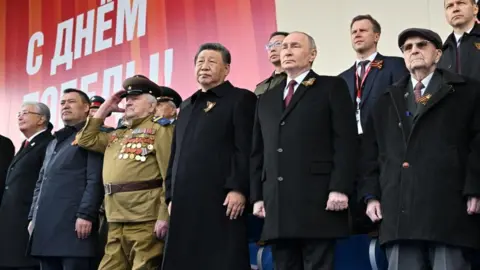 Ria Novosti/Efe
Ria Novosti/EfeVladimir Putin has led Russia’s Victory Day commemorations with a parade in Red Square and heightened security after days of Ukrainian strikes targeting the capital.
China’s Xi Jinping joined Putin as he told thousands of soldiers and more than 20 international leaders that Russia remembered the lessons of World War Two.
Putin used his speech to tie the war to today’s full-scale invasion of Ukraine, and said all of Russia was behind what he called the “special military operation” – now well into its fourth year.
For the first time, a column of trucks carrying various combat drones took part in the Victory Day parade, apparently because of their widescale use in Ukraine.
A unilateral, three-day ceasefire was announced by Russia to coincide with the lavish 80th anniversary event, which Ukraine rejected as a “theatrical show”.
Kyiv has labelled the truce as a farce, accusing Russia of launching thousands of attacks since it came into force at midnight on Wednesday. Russia says it has observed the ceasefire and accuses Ukraine of hundreds of violations.
In the hours before the ceasefire, Ukrainian drone strikes prompted airport closures and disruption for thousands of air passengers in Russia.
Heavy security and restrictions were in place in the centre of Moscow on Friday as Russia marked the Soviet Union’s victory over Nazi Germany.
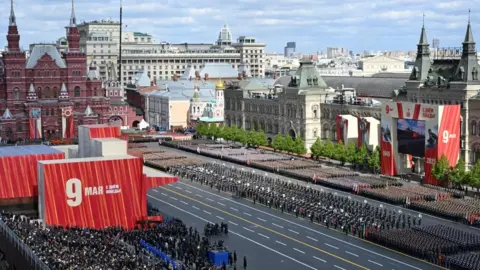 Reuters
ReutersBefore Putin’s address and a one-minute silence, the commander of ground troops, Oleg Salyukov, led 11,000 troops into Red Square, including some 1,500 who had fought in Ukraine. They were then inspected by Defence Minister Andrei Belousov.
Putin insisted that Russia “was and will be an indestructible barrier against Nazism, Russophobia, antisemitism”. The Russian leader has repeatedly and falsely referred to Ukraine’s leadership as Nazis.
“Truth and justice are on our side,” he said, insisting that “the “entire country, society and people support the participants” of the Ukraine war.
READ: Why did Putin’s Russia invade Ukraine?
Russia said 27 world leaders were attending the event, but it was the presence of China’s leader, alongside Putin and more than 100 Chinese soldiers marching on Red Square, that stood out.
China’s Xi Jinping had pride of place, sporting an orange and black St George ribbon, which Russia sees as a symbol of military glory but which has been banned by several neighbouring countries.
Russian state TV spoke of relations between the two countries as being at their highest-ever level, united against the “collective West”.
Russia’s pivot to the east was underlined by military contingents from North Korea, Vietnam and Mongolia.
Thousands of North Koreans have fought against Ukrainian forces in Russia’s Kursk region and Putin made a point of personally greeting some of the soldiers on Red Square, hugging one highly decorated officer.
North Korea’s Kim Jong Un visited the Russian embassy in Pyongyang to highlight his country’s increasing ties with Moscow.
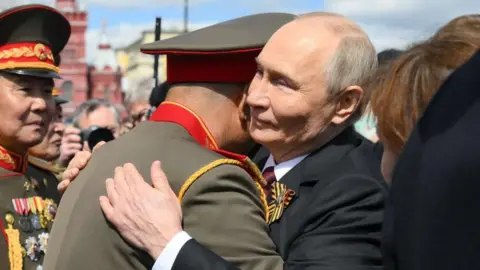 Ria Novosti
Ria NovostiBrazil’s Luiz Inácio Lula da Silva and Venezuelan President Nicolas Maduro were among the assembled guests, along with Serbian President Aleksandar Vucic and Robert Fico, Slovakia’s prime minister who is the only European Union leader to travel to Moscow.
EU foreign policy chief Kaja Kallas had earlier made clear that leaders of EU member states and countries aspiring to join the union should not take part in the event because of Russia’s war in Ukraine. Serbia is an EU candidate country and Vucic said he expected he would face consequences because of his decision to go.
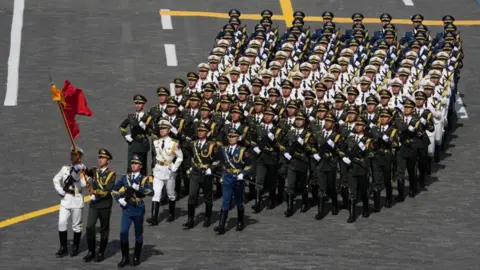 Ria Novosti/Handout
Ria Novosti/HandoutFor Putin, the attendance of China’s Xi on Victory Day is seen as a significant achievement, and he praised the “courageous people of China” as he paid tribute to Russia’s allies in World War Two.
Although Chinese forces played a prominent role in fighting against Japan, the government in Taiwan said Beijing and Moscow had distorted history. Taiwan said Chinese communist forces had made “no substantial contribution” in the war, unlike China’s then republican government, which later fled to Taiwan.
Putin and Xi held two rounds of talks before the parade as well as an informal chat on the war in Ukraine, Chinese reports said.
Joining the parade was a wide variety of Russian military hardware, including Yars missile systems, tanks and armoured personnel carriers. Six Su-25 military jets then flew over Red Square to complete the parade.
Ukraine’s Volodymyr Zelensky had earlier warned that he could not guarantee the safety of anyone attending the event and has urged heads of state not to travel to Moscow.
Mykhailo Samus, a Ukrainian military analyst and director of the New Geopolitics Research Network, told the BBC he believed that Ukraine would forego attacking the parade, largely because of the presence of foreign leaders.
But should Ukraine choose to do so, it would constitute a legitimate military target, Samus said.
During his evening address on Thursday, Zelensky said that Ukraine was “ready for a full ceasefire starting right now”.
“But it must be real,” he said in a video on X. “No missile or drone strikes, no hundreds of assaults on the front.”
He called on Russia to support the ceasefire and “prove their willingness to end the war”.
Ukraine has accused Russia of violating its own truce thousands of times since it was supposed to come into effect on Wednesday night.
On the second day of the truce, Ukraine said there had been nearly 200 clashes along the front line, eighteen Russian air strikes and almost four thousand instances of shelling by Russian troops.
In Prymorske, a village in the Zaporizhzhia region, a woman was reportedly killed after a Russian drone struck her car.
Russia’s defence ministry has said that all groups of Russian forces in Ukraine “completely ceased combat operations and remained on the previously occupied lines and positions”. However, they were reacting in a “mirror-like manner” to violations by Ukrainian forces.
Zelensky has repeatedly dismissed Putin’s proposal as a “game” and called for a longer truce of at least 30 days, something that is supported by Ukraine’s allies in Europe and the US.
He said he had spoken with US President Donald Trump to reiterate his readiness for a “long and lasting peace” and talks “in any format”. He said he had told Trump that a 30-day ceasefire was a “real indicator” of moving towards peace.
Writing on Truth Social on Thursday, the US president reiterated the call for an unconditional ceasefire and warned of further sanctions for any party failing to sign up to it.
Best birria and barbacoa tacos to try in Los Angeles
“When we started we wouldn’t even sell half a goat,” Barajas says. “By word of mouth and faith we started to get going week by week. There are a lot of people that make birria. But it has to be goat, and it’s supposed to have your special mole, a kind of rub, your own recipe. Maybe that’s why we have good clientele, because we make the rub, everything, every day.”
The most popular order is the plato birria de chivo con pistola, a bowl of the spicy, fall-off-the-bone goat meat bathed in consomé that comes with a shank and tortillas, onions, cilantro, radishes, chiles and lime wedges for composing your own tacos. Of course there are regular tacos, and there are tacos dorados, folded and fried, with cheese if you want quesabirria. Every order comes with a complimentary small fried bean taco, and the beans are a recipe from Barajas’ grandmother, who died earlier this year. “My grandmother told my dad to ‘give customers a nice gesture,’” Barajas says. And once a month Barajas Sr. still prepares montalayo, a fried ball of goat stomach with sausage-like tripe stuffing; order it chopped into a taco.


